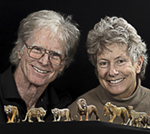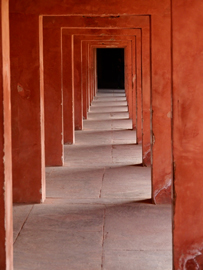
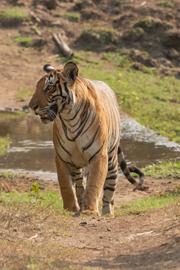
INDIA 2019
Tigers, Snow Leopards, Leopards, and Wildlife
TRIP REPORT
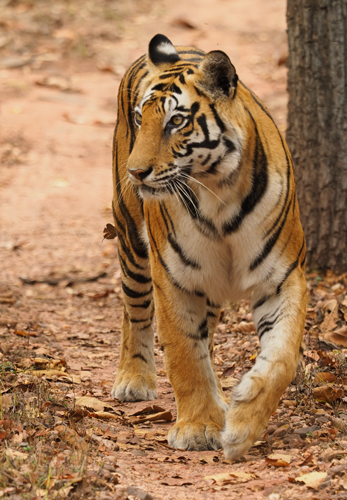 This year's trip to India was quite a bit different, and far more diverse, than any we've done in the past. Our 'Tiger' trip was actually a very abbreviated visit to Kanha and Bandhavgarh National Parks as part of a 'family trip' Mary had arranged for friends and family members. That trip included cultural sites as well ... more on that later.
This year's trip to India was quite a bit different, and far more diverse, than any we've done in the past. Our 'Tiger' trip was actually a very abbreviated visit to Kanha and Bandhavgarh National Parks as part of a 'family trip' Mary had arranged for friends and family members. That trip included cultural sites as well ... more on that later.
Afterwards, we did a 'normal' trip for Snow Leopards, and after spending time at 12,000-13,000 feet at 40 degrees or cooler temperatures, we ended with a 6 day trip to southern India for a Scouting Trip in quest of a melanistic Leopard, a Black Panther.
This year, both Mary and I only shot Olympus cameras and lenses, and I can honestly say doing so was a joy. I was able to borrow their new flagship camera, the M1X, which among its many new features includes hi-speed video, at 120 frames per second. That translates to 4 seconds of screen time for every second of 'real-time' shooting, and really captures details of action that occurs too quickly for you to appreciate in real time, as it happens.
Perhaps I was lazy or perhaps because two of the three trips were not official Tours, but at any rate I did not keep a day-to-day journal. Consequently, the report that follows is a concise review of the highlights of these three trips.
Perhaps most importantly, although we were thinking we could not return to India next year, we changed our minds and rearranged our schedule. We'll be doing a special Two week Tiger and wildlife trip next
year, 2020, and a big trip, incorporating several 'mini-trip' options in 2021. We love India, and despite its challenges, the shooting is intoxicating and addictive.
Here's the Report.
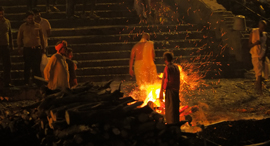
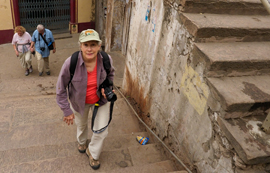
Trip One - Tigers and Culture
This ten day trip included only 8 game drives in Tiger country, in Kanha and in Bandhavgarh, and yet we had Tiger sightings on nearly all of our game drives! I saw 7 Tigers, and some of our friends/family saw 6. When you consider that we tell people on our photo tours that the 'normal' frequency of Tiger sightings in about 1 per every 3 game drives (for the group), we had exceptional luck. That statistic may not be entirely accurate these days, as last year, on our normal photo tour, we had an incredible 57 tiger sightings in two weeks! That being said, unlike in Africa where spotting lions or cheetahs is relatively easy on the open grasslands, encountering a Tiger is far more challenging. Regardless of what anyone claims, you simply cannot expect to see a Tiger on every game drive. If you do, you are exceptionally lucky, although I must say this year, and last, we all certainly were lucky!
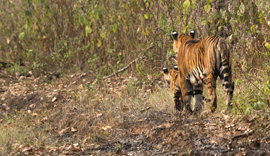 Our trip began, formally, in Kanha National Park. I love Kanha, and if I only had one park to visit in India, it would be here. Tiger sightings are not as common as in Bandhavgarh or some other locations, but the wildlife diversity is great, with a varied landscape and a variety of routes. We had exceptional luck, and on our first day my jeep encountered a mother Tigress with a cub that crossed the road ahead of us, after an exciting search as we followed the alarm calls of deer and monkeys. Incredibly, we arrived at a crossing point just seconds before the two Tigers stepped out of the forest and, after pausing a moment, crossed the road and disappeared.
Our trip began, formally, in Kanha National Park. I love Kanha, and if I only had one park to visit in India, it would be here. Tiger sightings are not as common as in Bandhavgarh or some other locations, but the wildlife diversity is great, with a varied landscape and a variety of routes. We had exceptional luck, and on our first day my jeep encountered a mother Tigress with a cub that crossed the road ahead of us, after an exciting search as we followed the alarm calls of deer and monkeys. Incredibly, we arrived at a crossing point just seconds before the two Tigers stepped out of the forest and, after pausing a moment, crossed the road and disappeared.
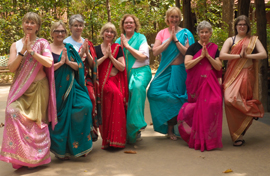
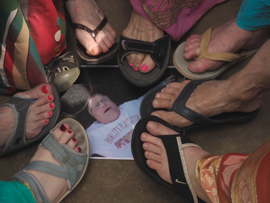
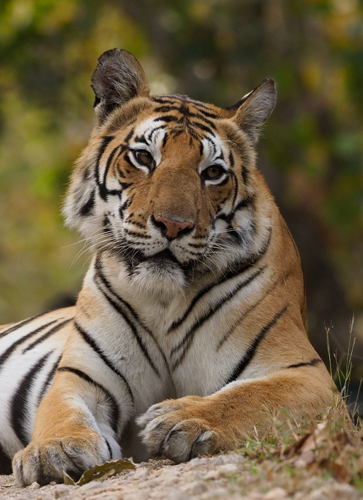
One of our favorite locations in Kanha is a small roadside pond called Baba Tinghaa, and one of our jeeps almost had a great sighting there but, unfortunately, drove on just minutes before a Tiger appeared and soaked in the close pond! On our last morning in Kanha, one couple, with me, had yet to see a Tiger, and a few 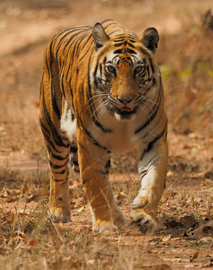 hundred yards from this pond we heard an explosive, snorting blast - the alarm call of a Sambar Deer. We waited, hoping that a Tiger would appear, but after ten minutes or so we moved on to Baba Tingha hoping to see a Tiger there. Just after arriving, our driver noticed another guide frantically waving to us ... the Tiger we had waited for had finally appeared, and crossed the track into an open field right where we had been! We quickly returned, and had a great view of a huge male Tiger as he confidently strode across the clearing and disappeared into the forest.
hundred yards from this pond we heard an explosive, snorting blast - the alarm call of a Sambar Deer. We waited, hoping that a Tiger would appear, but after ten minutes or so we moved on to Baba Tingha hoping to see a Tiger there. Just after arriving, our driver noticed another guide frantically waving to us ... the Tiger we had waited for had finally appeared, and crossed the track into an open field right where we had been! We quickly returned, and had a great view of a huge male Tiger as he confidently strode across the clearing and disappeared into the forest.
That afternoon, we headed to Bandhavgarh, our favorite park for sighting Tigers. Unfortunately, we only had one and an half days there, for a total of 3 game drives, and one of the best zones for seeing wildlife was closed, as a herd of aggressive wild Indian Elephants had moved in. Elephants are not native to this park -- at least not in recent years, and incredibly this herd of almost thirty animals had migrated in from a neighboring state, either traveling through the forested buffer zone or through farm fields and villages.
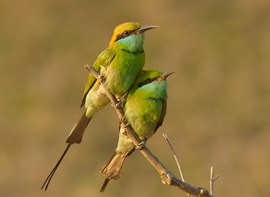
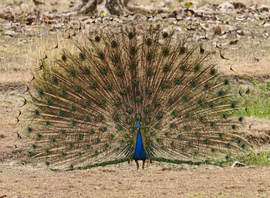
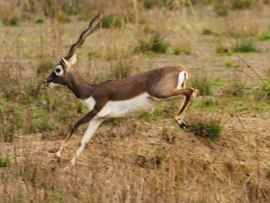
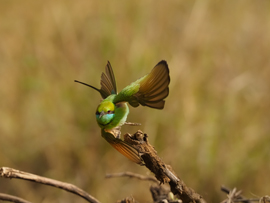
Wild Indian Elephants can be quite aggressive, and unlike their African Elephant cousins, they are prone to charge vehicles. Drivers wisely keep their distance, and in this case, a zone was closed for safety reasons. Accordingly, we had only two zones to visit, and one of those, Zone Three, is usually rather disappointing.
My friends, Tom and Deb, and I all had All-Day Permits, that allowed us to stay in the Park all day, and drive any road (excepting those in the Zone that was closed). These permits are expensive, but several Tigresses had cubs of varying ages, and this would maximize our chance of encountering one. I had no luck all morning (Tom and Deb had seen one in Zone Three in the AM), but shortly after noon my Park guide spotted a Tiger that subsequently crossed the road. Those sightings/encounters are pretty boring once you've seen a lot of Tigers, and I wasn't especially excited. Fortunately, the Tigress doubled back and stepped back onto the road, about 200 yards from our position and somehow, incredibly, our Park guide saw the Tigress walking down the track. He shouted 'Tiger on the road!' and we headed in that direction. We followed the unconcerned cat for several hundred yards before she moved to the side, allowing us to get ahead for more shots, before she laid down on the road in the shade of a tree. For the next two hours she slept, without another vehicle anywhere nearby. Finally, she got up, walked towards us, and, unexpectedly, disappeared into the forest, following a ravine to a small cave adjacent another road. This Tigress had cubs, and we were hoping she had hidden the cubs there (she didn't), and around 3PM she left the cave and crossed in front of the three of us(Tom and Deb had joined me) and disappeared into the forest -- providing a great view before doing so.
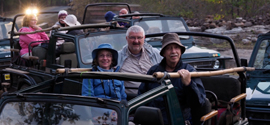
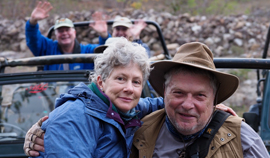
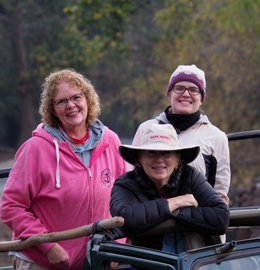
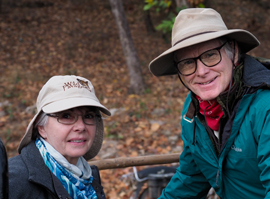
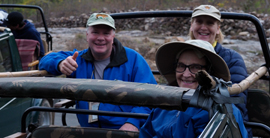
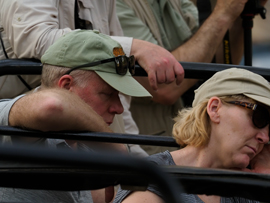 On our last day in Tiger land we were in Zone 3, where we learned that SIX Tigers were visible from the main road, where they had made a kill! Every vehicle converged in that area, but the Tigers had left. With only minutes remaining, I decided to leave the area and look for something other than an empty field where everyone else was, and I saw nothing. Minutes afterwards, one of the four cubs (the six included a Tigress and her four cubs, and an adult male at the kill) appeared, on a small hillside right above the main road.
On our last day in Tiger land we were in Zone 3, where we learned that SIX Tigers were visible from the main road, where they had made a kill! Every vehicle converged in that area, but the Tigers had left. With only minutes remaining, I decided to leave the area and look for something other than an empty field where everyone else was, and I saw nothing. Minutes afterwards, one of the four cubs (the six included a Tigress and her four cubs, and an adult male at the kill) appeared, on a small hillside right above the main road.
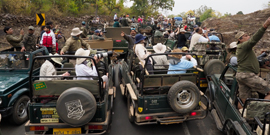 EVERY vehicle in the Park must have heard of this, for when I did, and my jeep arrived, the main road was a traffic jam of tourists and locals trying to see the tiger. We had some long waits, and some folks got sleepy. One person in our group had not yet seen a Tiger, but finally, on this last game drive, she did! Since my jeep arrived late, our view wasn't the best, but everyone in our group did see that tiger, concluding this exciting portion of the trip!
EVERY vehicle in the Park must have heard of this, for when I did, and my jeep arrived, the main road was a traffic jam of tourists and locals trying to see the tiger. We had some long waits, and some folks got sleepy. One person in our group had not yet seen a Tiger, but finally, on this last game drive, she did! Since my jeep arrived late, our view wasn't the best, but everyone in our group did see that tiger, concluding this exciting portion of the trip!
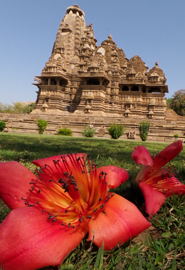
From Bandhavgarh we headed to Khajuraho for a visit to the Karma Sutra temples, and from there we flew to the sacred city of Varanasi on the Ganges. This started the 'cultural' aspect of the trip, which rounded out an India visit for the family and friends, and which, to me, was expected to be the most uninteresting and painful time I'd have in India. I was surprised.
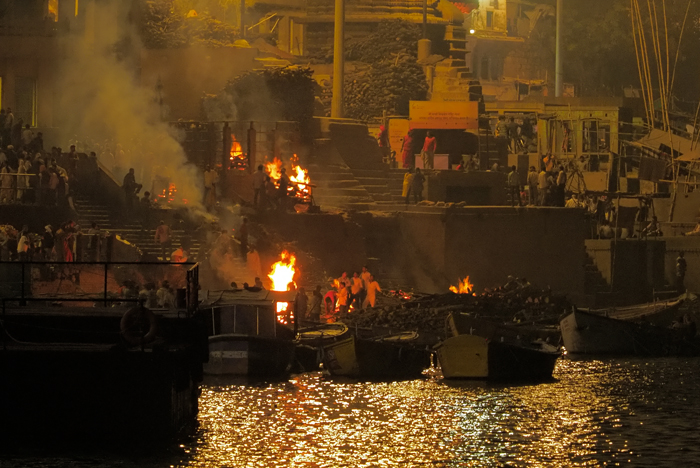 Varanasi proved to be quite interesting, highlighted, if you will, by a late afternoon/evening cruise down the Ganges as we photographed the city and the surreal scenes of cremations taking place near the river's edge. Between the artificial lights, the low ambient light, and the orange glow of bonfires (the cremations), the scene was truly surreal and magical, making for some very interesting images.
Varanasi proved to be quite interesting, highlighted, if you will, by a late afternoon/evening cruise down the Ganges as we photographed the city and the surreal scenes of cremations taking place near the river's edge. Between the artificial lights, the low ambient light, and the orange glow of bonfires (the cremations), the scene was truly surreal and magical, making for some very interesting images.
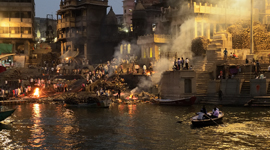
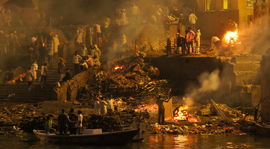
For anyone interested, the key to a cultural visit is THE GUIDE. We had a great one, Michael, a veteran of 19 years in Varanasi and a native-born Canadian. He made this visit, guiding us and interpreting the area wonderfully. From here we headed to Agra and the Taj Mahal where we had another spectacular guide, Ali, who has been the private guide for multiple Heads of State. Ali had a great eye for photography, and it was almost comical to be a part of a tour where he directed where we should be, at what time and at what angle, to get the best shots of the Taj. He was absolutely correct in every decision he made!
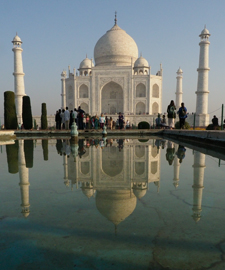
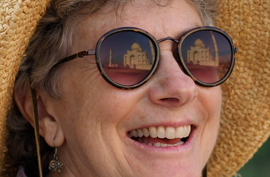

In 1993 we
made a similar shot of the two of us (right).
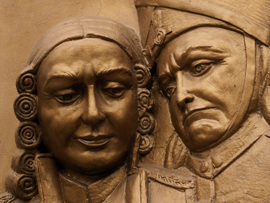
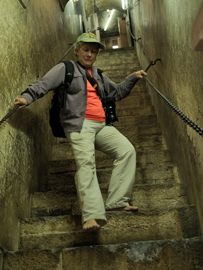
The highlight of that visit, however, was being inside the Taj early, when we were the only visitors inside. On our previous visits here, we were not, and being inside the Taj was like being in the worse Disneyland attraction possible. as people were herded along like cattle, whistles blowing to keep groups together and crowds shuffling and pushing, but that wasn't the case now. Instead, all alone inside this magnificent mausoleum, Ali directed our attention to the near silence, pointing out the sound of the wind funneling through the arches, strategically built for just that reason. At one point, Ali gave a short prayer/song, and we listened, enthralled, as the song reverberated as an echo for many seconds afterward. Despite the Taj's beauty, I've never enjoyed my visits here, until this time. Mary and I agreed that we could have listened to Ali's interpretation several days in a row ... there was so much to see and learn.
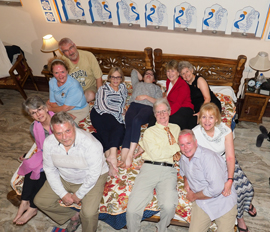
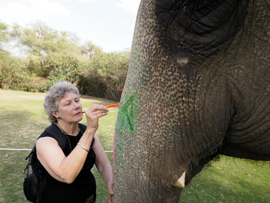
 We concluded our trip to the pink city of Jaipur, highlighted for many by a short Elephant ride through the forest and a fun and colorful stay at a wonderful family estate where we had Holi, the festival of colors that occurs in March each year. Holi is characterized by throwing colorful powders at one another, and three in our group, Mary's brother, cousin, and a friend, headed into the city to really experience the event. They came back very, very colorful, and that visit proved to be the highlight of their trip.
We concluded our trip to the pink city of Jaipur, highlighted for many by a short Elephant ride through the forest and a fun and colorful stay at a wonderful family estate where we had Holi, the festival of colors that occurs in March each year. Holi is characterized by throwing colorful powders at one another, and three in our group, Mary's brother, cousin, and a friend, headed into the city to really experience the event. They came back very, very colorful, and that visit proved to be the highlight of their trip.
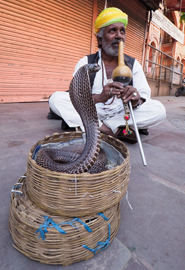
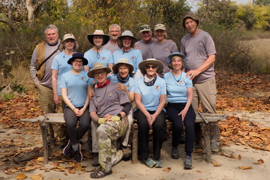
The Snow Leopard trip
After spending a day in Delhi Mary and I continued, with a group, to Leh in northern India, in the Himalayan mountains. Leh is located at over 11,000 feet, and after our time in the warm to hot low country of central India, Leh was a challenge. We spent our first two days simply acclimatizing, visiting monasteries and looking for 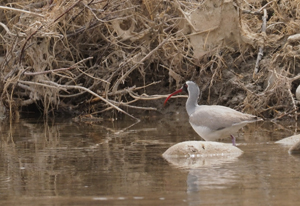 birds. One bird we hoped to see was endemic to the mountain streams here, the oddly shaped Ibisbill, a shorebird that vaguely resembles a curlew sandpiper. We found one, got shots, and, in following the bird upstream, were surprised when the bird took off nearby, in a completely unexpected spot. The bird's camouflage is excellent, despite the ease of seeing it when the bird is moving, but had we seen it before it flew ... well, we missed some nice shots!
birds. One bird we hoped to see was endemic to the mountain streams here, the oddly shaped Ibisbill, a shorebird that vaguely resembles a curlew sandpiper. We found one, got shots, and, in following the bird upstream, were surprised when the bird took off nearby, in a completely unexpected spot. The bird's camouflage is excellent, despite the ease of seeing it when the bird is moving, but had we seen it before it flew ... well, we missed some nice shots!
After acclimatizing in Leh we headed to the mountain 'village' of Ulley, where a comfortable lodge has been built, providing truly luxurious accommodations over what we endured in the past. On our previous trips we spend most of our time camping, where any liquids in our tents would freeze overnight if they were not in our sleeping bags, and where we enjoyed a miserable latrine. Now, at the lodge, we were warm, and comfortable ... so much so that we're planning on doing this trip again in 2021!
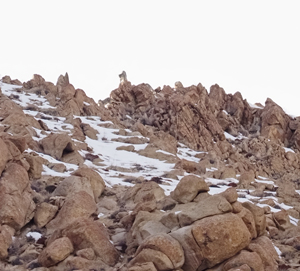 On our first afternoon we had luck -- a mother Snow Leopard with two half-grown cubs appeared on the ridge line above camp. We drove to the location (in contrast to having to hike everywhere on our past trips!) and we spotted the cats. They were high, and the views distant, but we watched as the cubs played and ran and jumped. Despite the distance, Mary and a few others got fairly decent stills, while I shot the trio on video with the new M1X.
On our first afternoon we had luck -- a mother Snow Leopard with two half-grown cubs appeared on the ridge line above camp. We drove to the location (in contrast to having to hike everywhere on our past trips!) and we spotted the cats. They were high, and the views distant, but we watched as the cubs played and ran and jumped. Despite the distance, Mary and a few others got fairly decent stills, while I shot the trio on video with the new M1X.
The following day we hiked up a canyon where, at the end of the hike, we spotted and photographed a large herd of Asiatic Ibex. These goat-like animals have sweeping, backward facing horns, and on previous trips we've only seen a few and at incredible distances. That afternoon, most of the group stayed around the lodge, where most of the spotters were 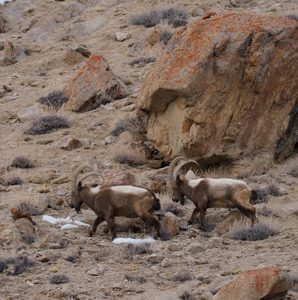 stationed to search for Leopards, while Pete, Julie, Randy, and I returned to the valley. This time, we hiked further up the hill towards the Ibex, where we had our best shots. I did mostly video, and by using the built-in telephoto digital doubler, I had frame-filling shots of the Ibex!
stationed to search for Leopards, while Pete, Julie, Randy, and I returned to the valley. This time, we hiked further up the hill towards the Ibex, where we had our best shots. I did mostly video, and by using the built-in telephoto digital doubler, I had frame-filling shots of the Ibex!
On another day we explored another location where we had a great shooting experience with another species of ungulate, the Urial. Six rams (they are a type of mountain sheep) were resting on a slope but while we watched the group headed down the mountainside towards water, giving us great views and shots of the large rams. I think the guides were moving around too much, as the rams stopped short and returned to higher ground, but treated us to some nice views and shots as they ran or jumped up the steep ledges.
As we headed towards home we found a Gray Wolf feeding upon a dead cow just outside of town. The wolf was cautious, and we couldn't get close, but we did manage some shots.
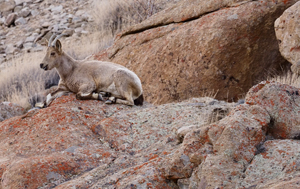 The following day one of our spotters sighted a Snow Leopard kill, an incredible spot that had to be nearly one mile away. He noticed a blood spot on the snow, then a drag and tracks, and then saw the cat. We drove down to the nearest viewing point, where we spent most of the day as the Leopard rested in the shade of a ledge far above the kill.
The following day one of our spotters sighted a Snow Leopard kill, an incredible spot that had to be nearly one mile away. He noticed a blood spot on the snow, then a drag and tracks, and then saw the cat. We drove down to the nearest viewing point, where we spent most of the day as the Leopard rested in the shade of a ledge far above the kill.
Meanwhile, our guides erected several 'hides' or blinds from old parachutes, and around 3PM everyone went inside. Soon the Snow Leopard left her resting spot, and started climbing uphill, calling and searching for her cubs. Incredibly, despite the distance, we could hear her calling, and I even recorded one series via the small microphones built in to the camera. Just prior to her meeting the cubs she appeared to be losing patience, with her last series of calls a rather emphatic and loud series of yelping calls. Check out our Snow Leopard video. The distance had to be close to a third of a mile away, making for very small images, but using the digital zoom, and video, I shot very satisfying video of the mother as she searched, and then her uniting with the cubs. She led them to the kill, where they remained until very late afternoon.
On our last morning one of our spotters saw another Snow Leopard. Pete was on location at the time and although he didn't photograph the cat, his visual, of the male back lighted by the rising sun as it walked across a snow-covered ridge line, was the highlight of his trip!
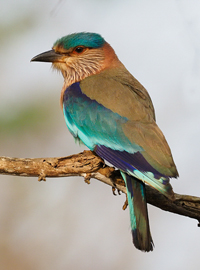
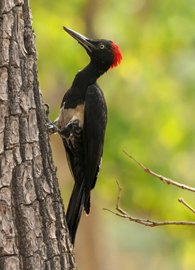
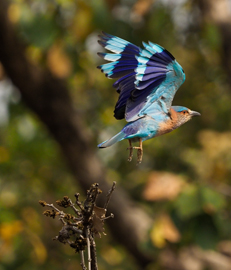
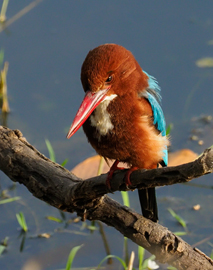
The Black Panther Scouting Trip
Most of our group continued on to southern India where we hoped to find and photograph what is perhaps the most striking and visually arresting cat in all of India -- a male, melanistic Leopard -- a Black Panther.
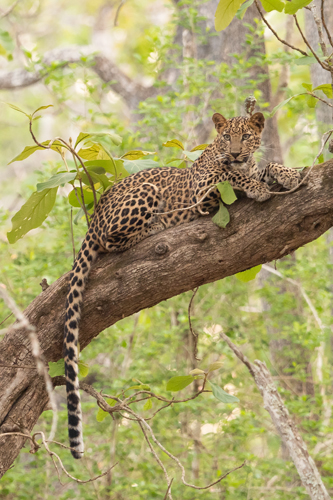
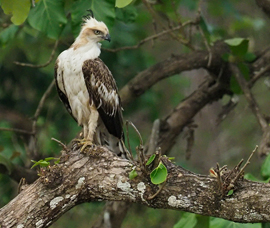 Right now, in 2019, I know of only two Black Panthers irregularly seen in India. One is a female in Tadoba, which has a rather unimpressive coat, appearing sparse and nearly gray, and the other, a beautiful truly black male is here at our location in Kabini, a part of Nagarhole Tiger Reserve in southern India.
Right now, in 2019, I know of only two Black Panthers irregularly seen in India. One is a female in Tadoba, which has a rather unimpressive coat, appearing sparse and nearly gray, and the other, a beautiful truly black male is here at our location in Kabini, a part of Nagarhole Tiger Reserve in southern India.
Like virtually all of India's tiger parks, Kabini has only a portion of its area open to tourist visitation. By law, this is supposed to be 20% of the total area, but in Kabini it is less than 8%. The ONE Black Panther known for this area spends much of his time in the area closed to tourists, making seeing this cat a true matter of luck.
The Kabini section is divided into two zones, A and B, and the Panther is found only in Zone A. Although the two zones seem similar, almost all Tiger and Leopard sightings occur in Zone A. Cats are in both, but far less frequently seen, although that zone (B) is best for wild Indian Elephants.
We planned on visiting A every morning, when we would have a longer visting time for finding the Black Leopard. Spoiler alert -- we were NOT successful. On our second full day in the Park, when we were assigned to Zone B, the Black Leopard was seen in Zone A, where it paraded on an open tree limb in full view for nearly 20 minutes! We saw Elephants that day .....
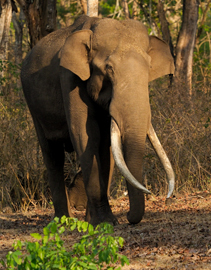 Regarding Elephants, we had very impressive sightings, including one bull with tusks that were probably larger than any we've seen on an African Elephant! Those tusks almost reached the ground, and another, which we missed, actually touch the ground! Our guide said, for this time of year he saw far more elephants than usual -- it was our best viewing, ever.
Regarding Elephants, we had very impressive sightings, including one bull with tusks that were probably larger than any we've seen on an African Elephant! Those tusks almost reached the ground, and another, which we missed, actually touch the ground! Our guide said, for this time of year he saw far more elephants than usual -- it was our best viewing, ever.
While we missed the Black Panther, we did have several sightings of spotted Leopards. On our last full day we had 7 different Leopards. In the morning, we arrived just as a large male Leopard completed his twenty minute stroll completely in the open. We got there just as he turned and headed into the brush. That evening, as we were leaving the park in near darkness, we had a female in the open, walking parallel to the main highway. It was so dark I couldn't get an exposure with stills, but on video, wow!, I got an incredible sequence in what seemed like no light. I could barely, barely distinguish the cat with my naked eye, yet on video it looks fine. Very impressive! That day we also had two Tigers and 7 Dhole, or Asiatic Wild Dogs!
In total, we had 9 different Tiger sightings, including a mother and three large cubs walking down a power line clearing, where the mother walked right by our vehicle.The cubs stopped short at a roadside waterhole, and after the Tigress walked by we drove to the water but the cubs were far in the back and moved off into the forest.
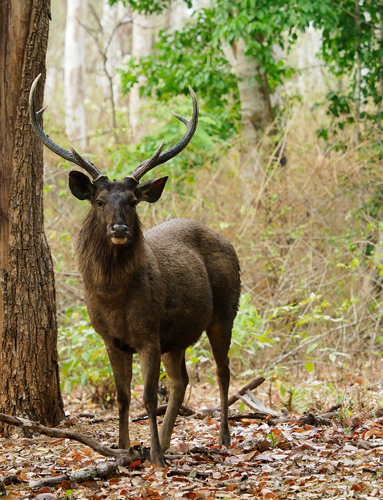 On our last full day we spent both our AM and PM drives in Zone A, maximizing our chances for the Black Panther. At one point, our guide thought he had it, about 150 yards away and up in a tree. At first, I thought I could make out the barely discernible spots on its rump, if it was facing away. 'Ears,' we quickly determined, were protrusions from a broken limb, and as we watched, and then magnified photos on our LCD screens, we realized we had a false alarm. While our guide and the Park driver were initially thrilled at finally spotting the cat, I wasn't too enthused, regardless. Had it been the Panther, it was a pretty miserable view, and I'd had hoped for more, if we were lucky.
On our last full day we spent both our AM and PM drives in Zone A, maximizing our chances for the Black Panther. At one point, our guide thought he had it, about 150 yards away and up in a tree. At first, I thought I could make out the barely discernible spots on its rump, if it was facing away. 'Ears,' we quickly determined, were protrusions from a broken limb, and as we watched, and then magnified photos on our LCD screens, we realized we had a false alarm. While our guide and the Park driver were initially thrilled at finally spotting the cat, I wasn't too enthused, regardless. Had it been the Panther, it was a pretty miserable view, and I'd had hoped for more, if we were lucky.
This park presented one other huge obstacle. The Park, itself, enjoys a monopoly on the vehicles, and no small jeeps are allowed (unless you're a government VIP, where anything is possible). Most visitors travel inside the park in a bus-like vehicle called a 'canter.' The sides are open, and there's a roof on top, which is great, actually, for protection from the sun. Our canter was a 14 seater, and for some of our game drives we had our 11 people, including Mary and I in that 11, and then 3 others from the camp, who filled in the empty spots. Had we not done so, the Park schedulers would have filled the empty spots with tourists staying at the Park Lodge. We visited that Lodge to check out the accommodations, which were fine, and IF you stay there, smaller jeeps, holding six people in three rows, are available. However, you MUST have six people, otherwise you run the risk of having just anyone filling the empty spots OR getting assigned to a large canter, with 14, 18, or 20+ seats.
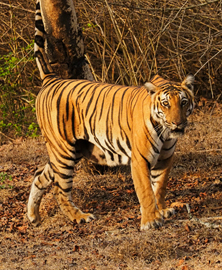
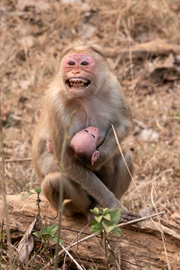
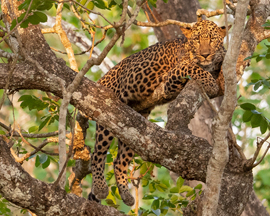
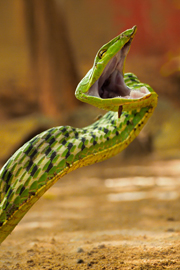
Nonetheless, with the 11 in our group, and 1 to 3 of the camp people also shooting, space was tight. Most of the Leopards we photographed were in trees, usually deeper into the forest where leaves or branches provided only limited windows for visibility. It was difficult to maneuver the canter to accommodate everyone for any Leopard, although we usually managed with some degree of compromise. Positioning one jeep, with 2 (as in Kanha or Bandhavgarh) or 4 people would be so much easier.
Supposedly, the Park monopoly is being challenged in court, with the plaintiffs hoping to be able to use their own camp jeeps, with fewer people aboard, and for the park hours (the most limited of any park we've been in) extended, and the tourist zone increased to the 20% that it is supposed to have. That hearing should occur in the next 4 to 6 months, so we'll see.
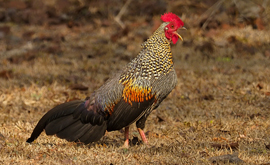
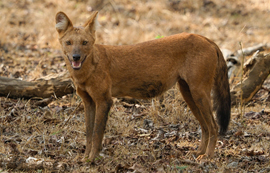
Ironically, our Camp - the Bison Camp or Lodge - has its own canter that was far more spacious. It could easily accommodate ten people - even if a few rows would have 3 people per row, there was still far more room for getting into position. Since, at present, there is only ONE Black Panther, a group would be better off, perhaps, in one vehicle, insuring that everyone had the same luck. Otherwise, in several vehicles, some folks very well might be unlucky, and very frustrated and unhappy.
All said, we're hoping to return, even if it is just for a private trip. And hopefully, things will change and this park will offer more favorable terms, as the other parks we visit do. We'll see.
Why you should travel with us
Testimonials
Join us on Facebook at: Follow Hoot Hollow
Office Phone: (717) 543-6423
Or FAX us at: (717) 543-5342
Mary and Joe are proud to endorse the Photo Retailer that has
done the absolute most in supporting nature photography in all
its facets ---

Check out the Monthly Specials
from Hunt's
Check out these TPPA specials!


INDIA 2019
Tigers, Snow Leopards, Leopards, and Wildlife
TRIP REPORT
 This year's trip to India was quite a bit different, and far more diverse, than any we've done in the past. Our 'Tiger' trip was actually a very abbreviated visit to Kanha and Bandhavgarh National Parks as part of a 'family trip' Mary had arranged for friends and family members. That trip included cultural sites as well ... more on that later.
This year's trip to India was quite a bit different, and far more diverse, than any we've done in the past. Our 'Tiger' trip was actually a very abbreviated visit to Kanha and Bandhavgarh National Parks as part of a 'family trip' Mary had arranged for friends and family members. That trip included cultural sites as well ... more on that later.
Afterwards, we did a 'normal' trip for Snow Leopards, and after spending time at 12,000-13,000 feet at 40 degrees or cooler temperatures, we ended with a 6 day trip to southern India for a Scouting Trip in quest of a melanistic Leopard, a Black Panther.
This year, both Mary and I only shot Olympus cameras and lenses, and I can honestly say doing so was a joy. I was able to borrow their new flagship camera, the M1X, which among its many new features includes hi-speed video, at 120 frames per second. That translates to 4 seconds of screen time for every second of 'real-time' shooting, and really captures details of action that occurs too quickly for you to appreciate in real time, as it happens.
Perhaps I was lazy or perhaps because two of the three trips were not official Tours, but at any rate I did not keep a day-to-day journal. Consequently, the report that follows is a concise review of the highlights of these three trips.
Perhaps most importantly, although we were thinking we could not return to India next year, we changed our minds and rearranged our schedule. We'll be doing a special Two week Tiger and wildlife trip next
year, 2020, and a big trip, incorporating several 'mini-trip' options in 2021. We love India, and despite its challenges, the shooting is intoxicating and addictive.
Here's the Report.


Trip One - Tigers and Culture
This ten day trip included only 8 game drives in Tiger country, in Kanha and in Bandhavgarh, and yet we had Tiger sightings on nearly all of our game drives! I saw 7 Tigers, and some of our friends/family saw 6. When you consider that we tell people on our photo tours that the 'normal' frequency of Tiger sightings in about 1 per every 3 game drives (for the group), we had exceptional luck. That statistic may not be entirely accurate these days, as last year, on our normal photo tour, we had an incredible 57 tiger sightings in two weeks! That being said, unlike in Africa where spotting lions or cheetahs is relatively easy on the open grasslands, encountering a Tiger is far more challenging. Regardless of what anyone claims, you simply cannot expect to see a Tiger on every game drive. If you do, you are exceptionally lucky, although I must say this year, and last, we all certainly were lucky!
 Our trip began, formally, in Kanha National Park. I love Kanha, and if I only had one park to visit in India, it would be here. Tiger sightings are not as common as in Bandhavgarh or some other locations, but the wildlife diversity is great, with a varied landscape and a variety of routes. We had exceptional luck, and on our first day my jeep encountered a mother Tigress with a cub that crossed the road ahead of us, after an exciting search as we followed the alarm calls of deer and monkeys. Incredibly, we arrived at a crossing point just seconds before the two Tigers stepped out of the forest and, after pausing a moment, crossed the road and disappeared.
Our trip began, formally, in Kanha National Park. I love Kanha, and if I only had one park to visit in India, it would be here. Tiger sightings are not as common as in Bandhavgarh or some other locations, but the wildlife diversity is great, with a varied landscape and a variety of routes. We had exceptional luck, and on our first day my jeep encountered a mother Tigress with a cub that crossed the road ahead of us, after an exciting search as we followed the alarm calls of deer and monkeys. Incredibly, we arrived at a crossing point just seconds before the two Tigers stepped out of the forest and, after pausing a moment, crossed the road and disappeared.



One of our favorite locations in Kanha is a small roadside pond called Baba Tinghaa, and one of our jeeps almost had a great sighting there but, unfortunately, drove on just minutes before a Tiger appeared and soaked in the close pond! On our last morning in Kanha, one couple, with me, had yet to see a Tiger, and a few  hundred yards from this pond we heard an explosive, snorting blast - the alarm call of a Sambar Deer. We waited, hoping that a Tiger would appear, but after ten minutes or so we moved on to Baba Tingha hoping to see a Tiger there. Just after arriving, our driver noticed another guide frantically waving to us ... the Tiger we had waited for had finally appeared, and crossed the track into an open field right where we had been! We quickly returned, and had a great view of a huge male Tiger as he confidently strode across the clearing and disappeared into the forest.
hundred yards from this pond we heard an explosive, snorting blast - the alarm call of a Sambar Deer. We waited, hoping that a Tiger would appear, but after ten minutes or so we moved on to Baba Tingha hoping to see a Tiger there. Just after arriving, our driver noticed another guide frantically waving to us ... the Tiger we had waited for had finally appeared, and crossed the track into an open field right where we had been! We quickly returned, and had a great view of a huge male Tiger as he confidently strode across the clearing and disappeared into the forest.
That afternoon, we headed to Bandhavgarh, our favorite park for sighting Tigers. Unfortunately, we only had one and an half days there, for a total of 3 game drives, and one of the best zones for seeing wildlife was closed, as a herd of aggressive wild Indian Elephants had moved in. Elephants are not native to this park -- at least not in recent years, and incredibly this herd of almost thirty animals had migrated in from a neighboring state, either traveling through the forested buffer zone or through farm fields and villages.




Wild Indian Elephants can be quite aggressive, and unlike their African Elephant cousins, they are prone to charge vehicles. Drivers wisely keep their distance, and in this case, a zone was closed for safety reasons. Accordingly, we had only two zones to visit, and one of those, Zone Three, is usually rather disappointing.
My friends, Tom and Deb, and I all had All-Day Permits, that allowed us to stay in the Park all day, and drive any road (excepting those in the Zone that was closed). These permits are expensive, but several Tigresses had cubs of varying ages, and this would maximize our chance of encountering one. I had no luck all morning (Tom and Deb had seen one in Zone Three in the AM), but shortly after noon my Park guide spotted a Tiger that subsequently crossed the road. Those sightings/encounters are pretty boring once you've seen a lot of Tigers, and I wasn't especially excited. Fortunately, the Tigress doubled back and stepped back onto the road, about 200 yards from our position and somehow, incredibly, our Park guide saw the Tigress walking down the track. He shouted 'Tiger on the road!' and we headed in that direction. We followed the unconcerned cat for several hundred yards before she moved to the side, allowing us to get ahead for more shots, before she laid down on the road in the shade of a tree. For the next two hours she slept, without another vehicle anywhere nearby. Finally, she got up, walked towards us, and, unexpectedly, disappeared into the forest, following a ravine to a small cave adjacent another road. This Tigress had cubs, and we were hoping she had hidden the cubs there (she didn't), and around 3PM she left the cave and crossed in front of the three of us(Tom and Deb had joined me) and disappeared into the forest -- providing a great view before doing so.





 On our last day in Tiger land we were in Zone 3, where we learned that SIX Tigers were visible from the main road, where they had made a kill! Every vehicle converged in that area, but the Tigers had left. With only minutes remaining, I decided to leave the area and look for something other than an empty field where everyone else was, and I saw nothing. Minutes afterwards, one of the four cubs (the six included a Tigress and her four cubs, and an adult male at the kill) appeared, on a small hillside right above the main road.
On our last day in Tiger land we were in Zone 3, where we learned that SIX Tigers were visible from the main road, where they had made a kill! Every vehicle converged in that area, but the Tigers had left. With only minutes remaining, I decided to leave the area and look for something other than an empty field where everyone else was, and I saw nothing. Minutes afterwards, one of the four cubs (the six included a Tigress and her four cubs, and an adult male at the kill) appeared, on a small hillside right above the main road.
 EVERY vehicle in the Park must have heard of this, for when I did, and my jeep arrived, the main road was a traffic jam of tourists and locals trying to see the tiger. We had some long waits, and some folks got sleepy. One person in our group had not yet seen a Tiger, but finally, on this last game drive, she did! Since my jeep arrived late, our view wasn't the best, but everyone in our group did see that tiger, concluding this exciting portion of the trip!
EVERY vehicle in the Park must have heard of this, for when I did, and my jeep arrived, the main road was a traffic jam of tourists and locals trying to see the tiger. We had some long waits, and some folks got sleepy. One person in our group had not yet seen a Tiger, but finally, on this last game drive, she did! Since my jeep arrived late, our view wasn't the best, but everyone in our group did see that tiger, concluding this exciting portion of the trip!

From Bandhavgarh we headed to Khajuraho for a visit to the Karma Sutra temples, and from there we flew to the sacred city of Varanasi on the Ganges. This started the 'cultural' aspect of the trip, which rounded out an India visit for the family and friends, and which, to me, was expected to be the most uninteresting and painful time I'd have in India. I was surprised.
 Varanasi proved to be quite interesting, highlighted, if you will, by a late afternoon/evening cruise down the Ganges as we photographed the city and the surreal scenes of cremations taking place near the river's edge. Between the artificial lights, the low ambient light, and the orange glow of bonfires (the cremations), the scene was truly surreal and magical, making for some very interesting images.
Varanasi proved to be quite interesting, highlighted, if you will, by a late afternoon/evening cruise down the Ganges as we photographed the city and the surreal scenes of cremations taking place near the river's edge. Between the artificial lights, the low ambient light, and the orange glow of bonfires (the cremations), the scene was truly surreal and magical, making for some very interesting images.


For anyone interested, the key to a cultural visit is THE GUIDE. We had a great one, Michael, a veteran of 19 years in Varanasi and a native-born Canadian. He made this visit, guiding us and interpreting the area wonderfully. From here we headed to Agra and the Taj Mahal where we had another spectacular guide, Ali, who has been the private guide for multiple Heads of State. Ali had a great eye for photography, and it was almost comical to be a part of a tour where he directed where we should be, at what time and at what angle, to get the best shots of the Taj. He was absolutely correct in every decision he made!



In 1993 we
made a similar shot of the two of us (right).


The highlight of that visit, however, was being inside the Taj early, when we were the only visitors inside. On our previous visits here, we were not, and being inside the Taj was like being in the worse Disneyland attraction possible. as people were herded along like cattle, whistles blowing to keep groups together and crowds shuffling and pushing, but that wasn't the case now. Instead, all alone inside this magnificent mausoleum, Ali directed our attention to the near silence, pointing out the sound of the wind funneling through the arches, strategically built for just that reason. At one point, Ali gave a short prayer/song, and we listened, enthralled, as the song reverberated as an echo for many seconds afterward. Despite the Taj's beauty, I've never enjoyed my visits here, until this time. Mary and I agreed that we could have listened to Ali's interpretation several days in a row ... there was so much to see and learn.


 We concluded our trip to the pink city of Jaipur, highlighted for many by a short Elephant ride through the forest and a fun and colorful stay at a wonderful family estate where we had Holi, the festival of colors that occurs in March each year. Holi is characterized by throwing colorful powders at one another, and three in our group, Mary's brother, cousin, and a friend, headed into the city to really experience the event. They came back very, very colorful, and that visit proved to be the highlight of their trip.
We concluded our trip to the pink city of Jaipur, highlighted for many by a short Elephant ride through the forest and a fun and colorful stay at a wonderful family estate where we had Holi, the festival of colors that occurs in March each year. Holi is characterized by throwing colorful powders at one another, and three in our group, Mary's brother, cousin, and a friend, headed into the city to really experience the event. They came back very, very colorful, and that visit proved to be the highlight of their trip.


The Snow Leopard trip
After spending a day in Delhi Mary and I continued, with a group, to Leh in northern India, in the Himalayan mountains. Leh is located at over 11,000 feet, and after our time in the warm to hot low country of central India, Leh was a challenge. We spent our first two days simply acclimatizing, visiting monasteries and looking for  birds. One bird we hoped to see was endemic to the mountain streams here, the oddly shaped Ibisbill, a shorebird that vaguely resembles a curlew sandpiper. We found one, got shots, and, in following the bird upstream, were surprised when the bird took off nearby, in a completely unexpected spot. The bird's camouflage is excellent, despite the ease of seeing it when the bird is moving, but had we seen it before it flew ... well, we missed some nice shots!
birds. One bird we hoped to see was endemic to the mountain streams here, the oddly shaped Ibisbill, a shorebird that vaguely resembles a curlew sandpiper. We found one, got shots, and, in following the bird upstream, were surprised when the bird took off nearby, in a completely unexpected spot. The bird's camouflage is excellent, despite the ease of seeing it when the bird is moving, but had we seen it before it flew ... well, we missed some nice shots!
After acclimatizing in Leh we headed to the mountain 'village' of Ulley, where a comfortable lodge has been built, providing truly luxurious accommodations over what we endured in the past. On our previous trips we spend most of our time camping, where any liquids in our tents would freeze overnight if they were not in our sleeping bags, and where we enjoyed a miserable latrine. Now, at the lodge, we were warm, and comfortable ... so much so that we're planning on doing this trip again in 2021!
 On our first afternoon we had luck -- a mother Snow Leopard with two half-grown cubs appeared on the ridge line above camp. We drove to the location (in contrast to having to hike everywhere on our past trips!) and we spotted the cats. They were high, and the views distant, but we watched as the cubs played and ran and jumped. Despite the distance, Mary and a few others got fairly decent stills, while I shot the trio on video with the new M1X.
On our first afternoon we had luck -- a mother Snow Leopard with two half-grown cubs appeared on the ridge line above camp. We drove to the location (in contrast to having to hike everywhere on our past trips!) and we spotted the cats. They were high, and the views distant, but we watched as the cubs played and ran and jumped. Despite the distance, Mary and a few others got fairly decent stills, while I shot the trio on video with the new M1X.
The following day we hiked up a canyon where, at the end of the hike, we spotted and photographed a large herd of Asiatic Ibex. These goat-like animals have sweeping, backward facing horns, and on previous trips we've only seen a few and at incredible distances. That afternoon, most of the group stayed around the lodge, where most of the spotters were  stationed to search for Leopards, while Pete, Julie, Randy, and I returned to the valley. This time, we hiked further up the hill towards the Ibex, where we had our best shots. I did mostly video, and by using the built-in telephoto digital doubler, I had frame-filling shots of the Ibex!
stationed to search for Leopards, while Pete, Julie, Randy, and I returned to the valley. This time, we hiked further up the hill towards the Ibex, where we had our best shots. I did mostly video, and by using the built-in telephoto digital doubler, I had frame-filling shots of the Ibex!
On another day we explored another location where we had a great shooting experience with another species of ungulate, the Urial. Six rams (they are a type of mountain sheep) were resting on a slope but while we watched the group headed down the mountainside towards water, giving us great views and shots of the large rams. I think the guides were moving around too much, as the rams stopped short and returned to higher ground, but treated us to some nice views and shots as they ran or jumped up the steep ledges.
As we headed towards home we found a Gray Wolf feeding upon a dead cow just outside of town. The wolf was cautious, and we couldn't get close, but we did manage some shots.
 The following day one of our spotters sighted a Snow Leopard kill, an incredible spot that had to be nearly one mile away. He noticed a blood spot on the snow, then a drag and tracks, and then saw the cat. We drove down to the nearest viewing point, where we spent most of the day as the Leopard rested in the shade of a ledge far above the kill.
The following day one of our spotters sighted a Snow Leopard kill, an incredible spot that had to be nearly one mile away. He noticed a blood spot on the snow, then a drag and tracks, and then saw the cat. We drove down to the nearest viewing point, where we spent most of the day as the Leopard rested in the shade of a ledge far above the kill.
Meanwhile, our guides erected several 'hides' or blinds from old parachutes, and around 3PM everyone went inside. Soon the Snow Leopard left her resting spot, and started climbing uphill, calling and searching for her cubs. Incredibly, despite the distance, we could hear her calling, and I even recorded one series via the small microphones built in to the camera. Just prior to her meeting the cubs she appeared to be losing patience, with her last series of calls a rather emphatic and loud series of yelping calls. Check out our Snow Leopard video. The distance had to be close to a third of a mile away, making for very small images, but using the digital zoom, and video, I shot very satisfying video of the mother as she searched, and then her uniting with the cubs. She led them to the kill, where they remained until very late afternoon.
On our last morning one of our spotters saw another Snow Leopard. Pete was on location at the time and although he didn't photograph the cat, his visual, of the male back lighted by the rising sun as it walked across a snow-covered ridge line, was the highlight of his trip!




The Black Panther Scouting Trip
Most of our group continued on to southern India where we hoped to find and photograph what is perhaps the most striking and visually arresting cat in all of India -- a male, melanistic Leopard -- a Black Panther.

 Right now, in 2019, I know of only two Black Panthers irregularly seen in India. One is a female in Tadoba, which has a rather unimpressive coat, appearing sparse and nearly gray, and the other, a beautiful truly black male is here at our location in Kabini, a part of Nagarhole Tiger Reserve in southern India.
Right now, in 2019, I know of only two Black Panthers irregularly seen in India. One is a female in Tadoba, which has a rather unimpressive coat, appearing sparse and nearly gray, and the other, a beautiful truly black male is here at our location in Kabini, a part of Nagarhole Tiger Reserve in southern India.
Like virtually all of India's tiger parks, Kabini has only a portion of its area open to tourist visitation. By law, this is supposed to be 20% of the total area, but in Kabini it is less than 8%. The ONE Black Panther known for this area spends much of his time in the area closed to tourists, making seeing this cat a true matter of luck.
The Kabini section is divided into two zones, A and B, and the Panther is found only in Zone A. Although the two zones seem similar, almost all Tiger and Leopard sightings occur in Zone A. Cats are in both, but far less frequently seen, although that zone (B) is best for wild Indian Elephants.
We planned on visiting A every morning, when we would have a longer visting time for finding the Black Leopard. Spoiler alert -- we were NOT successful. On our second full day in the Park, when we were assigned to Zone B, the Black Leopard was seen in Zone A, where it paraded on an open tree limb in full view for nearly 20 minutes! We saw Elephants that day .....
 Regarding Elephants, we had very impressive sightings, including one bull with tusks that were probably larger than any we've seen on an African Elephant! Those tusks almost reached the ground, and another, which we missed, actually touch the ground! Our guide said, for this time of year he saw far more elephants than usual -- it was our best viewing, ever.
Regarding Elephants, we had very impressive sightings, including one bull with tusks that were probably larger than any we've seen on an African Elephant! Those tusks almost reached the ground, and another, which we missed, actually touch the ground! Our guide said, for this time of year he saw far more elephants than usual -- it was our best viewing, ever.
While we missed the Black Panther, we did have several sightings of spotted Leopards. On our last full day we had 7 different Leopards. In the morning, we arrived just as a large male Leopard completed his twenty minute stroll completely in the open. We got there just as he turned and headed into the brush. That evening, as we were leaving the park in near darkness, we had a female in the open, walking parallel to the main highway. It was so dark I couldn't get an exposure with stills, but on video, wow!, I got an incredible sequence in what seemed like no light. I could barely, barely distinguish the cat with my naked eye, yet on video it looks fine. Very impressive! That day we also had two Tigers and 7 Dhole, or Asiatic Wild Dogs!
In total, we had 9 different Tiger sightings, including a mother and three large cubs walking down a power line clearing, where the mother walked right by our vehicle.The cubs stopped short at a roadside waterhole, and after the Tigress walked by we drove to the water but the cubs were far in the back and moved off into the forest.
 On our last full day we spent both our AM and PM drives in Zone A, maximizing our chances for the Black Panther. At one point, our guide thought he had it, about 150 yards away and up in a tree. At first, I thought I could make out the barely discernible spots on its rump, if it was facing away. 'Ears,' we quickly determined, were protrusions from a broken limb, and as we watched, and then magnified photos on our LCD screens, we realized we had a false alarm. While our guide and the Park driver were initially thrilled at finally spotting the cat, I wasn't too enthused, regardless. Had it been the Panther, it was a pretty miserable view, and I'd had hoped for more, if we were lucky.
On our last full day we spent both our AM and PM drives in Zone A, maximizing our chances for the Black Panther. At one point, our guide thought he had it, about 150 yards away and up in a tree. At first, I thought I could make out the barely discernible spots on its rump, if it was facing away. 'Ears,' we quickly determined, were protrusions from a broken limb, and as we watched, and then magnified photos on our LCD screens, we realized we had a false alarm. While our guide and the Park driver were initially thrilled at finally spotting the cat, I wasn't too enthused, regardless. Had it been the Panther, it was a pretty miserable view, and I'd had hoped for more, if we were lucky.
This park presented one other huge obstacle. The Park, itself, enjoys a monopoly on the vehicles, and no small jeeps are allowed (unless you're a government VIP, where anything is possible). Most visitors travel inside the park in a bus-like vehicle called a 'canter.' The sides are open, and there's a roof on top, which is great, actually, for protection from the sun. Our canter was a 14 seater, and for some of our game drives we had our 11 people, including Mary and I in that 11, and then 3 others from the camp, who filled in the empty spots. Had we not done so, the Park schedulers would have filled the empty spots with tourists staying at the Park Lodge. We visited that Lodge to check out the accommodations, which were fine, and IF you stay there, smaller jeeps, holding six people in three rows, are available. However, you MUST have six people, otherwise you run the risk of having just anyone filling the empty spots OR getting assigned to a large canter, with 14, 18, or 20+ seats.




Nonetheless, with the 11 in our group, and 1 to 3 of the camp people also shooting, space was tight. Most of the Leopards we photographed were in trees, usually deeper into the forest where leaves or branches provided only limited windows for visibility. It was difficult to maneuver the canter to accommodate everyone for any Leopard, although we usually managed with some degree of compromise. Positioning one jeep, with 2 (as in Kanha or Bandhavgarh) or 4 people would be so much easier.
Supposedly, the Park monopoly is being challenged in court, with the plaintiffs hoping to be able to use their own camp jeeps, with fewer people aboard, and for the park hours (the most limited of any park we've been in) extended, and the tourist zone increased to the 20% that it is supposed to have. That hearing should occur in the next 4 to 6 months, so we'll see.


Ironically, our Camp - the Bison Camp or Lodge - has its own canter that was far more spacious. It could easily accommodate ten people - even if a few rows would have 3 people per row, there was still far more room for getting into position. Since, at present, there is only ONE Black Panther, a group would be better off, perhaps, in one vehicle, insuring that everyone had the same luck. Otherwise, in several vehicles, some folks very well might be unlucky, and very frustrated and unhappy.
All said, we're hoping to return, even if it is just for a private trip. And hopefully, things will change and this park will offer more favorable terms, as the other parks we visit do. We'll see.
Why you should travel with us
Testimonials
Join us on Facebook at: Follow Hoot Hollow
Office Phone: (717) 543-6423
Or FAX us at: (717) 543-5342
Mary and Joe are proud to endorse the Photo Retailer that has
done the absolute most in supporting nature photography in all
its facets ---

Check out the Monthly Specials
from Hunt's
Check out these TPPA specials!


INDIA 2019
Tigers, Snow Leopards, Leopards, and Wildlife
TRIP REPORT
 This year's trip to India was quite a bit different, and far more diverse, than any we've done in the past. Our 'Tiger' trip was actually a very abbreviated visit to Kanha and Bandhavgarh National Parks as part of a 'family trip' Mary had arranged for friends and family members. That trip included cultural sites as well ... more on that later.
This year's trip to India was quite a bit different, and far more diverse, than any we've done in the past. Our 'Tiger' trip was actually a very abbreviated visit to Kanha and Bandhavgarh National Parks as part of a 'family trip' Mary had arranged for friends and family members. That trip included cultural sites as well ... more on that later.
Afterwards, we did a 'normal' trip for Snow Leopards, and after spending time at 12,000-13,000 feet at 40 degrees or cooler temperatures, we ended with a 6 day trip to southern India for a Scouting Trip in quest of a melanistic Leopard, a Black Panther.
This year, both Mary and I only shot Olympus cameras and lenses, and I can honestly say doing so was a joy. I was able to borrow their new flagship camera, the M1X, which among its many new features includes hi-speed video, at 120 frames per second. That translates to 4 seconds of screen time for every second of 'real-time' shooting, and really captures details of action that occurs too quickly for you to appreciate in real time, as it happens.
Perhaps I was lazy or perhaps because two of the three trips were not official Tours, but at any rate I did not keep a day-to-day journal. Consequently, the report that follows is a concise review of the highlights of these three trips.
Perhaps most importantly, although we were thinking we could not return to India next year, we changed our minds and rearranged our schedule. We'll be doing a special Two week Tiger and wildlife trip next
year, 2020, and a big trip, incorporating several 'mini-trip' options in 2021. We love India, and despite its challenges, the shooting is intoxicating and addictive.
Here's the Report.


Trip One - Tigers and Culture
This ten day trip included only 8 game drives in Tiger country, in Kanha and in Bandhavgarh, and yet we had Tiger sightings on nearly all of our game drives! I saw 7 Tigers, and some of our friends/family saw 6. When you consider that we tell people on our photo tours that the 'normal' frequency of Tiger sightings in about 1 per every 3 game drives (for the group), we had exceptional luck. That statistic may not be entirely accurate these days, as last year, on our normal photo tour, we had an incredible 57 tiger sightings in two weeks! That being said, unlike in Africa where spotting lions or cheetahs is relatively easy on the open grasslands, encountering a Tiger is far more challenging. Regardless of what anyone claims, you simply cannot expect to see a Tiger on every game drive. If you do, you are exceptionally lucky, although I must say this year, and last, we all certainly were lucky!
 Our trip began, formally, in Kanha National Park. I love Kanha, and if I only had one park to visit in India, it would be here. Tiger sightings are not as common as in Bandhavgarh or some other locations, but the wildlife diversity is great, with a varied landscape and a variety of routes. We had exceptional luck, and on our first day my jeep encountered a mother Tigress with a cub that crossed the road ahead of us, after an exciting search as we followed the alarm calls of deer and monkeys. Incredibly, we arrived at a crossing point just seconds before the two Tigers stepped out of the forest and, after pausing a moment, crossed the road and disappeared.
Our trip began, formally, in Kanha National Park. I love Kanha, and if I only had one park to visit in India, it would be here. Tiger sightings are not as common as in Bandhavgarh or some other locations, but the wildlife diversity is great, with a varied landscape and a variety of routes. We had exceptional luck, and on our first day my jeep encountered a mother Tigress with a cub that crossed the road ahead of us, after an exciting search as we followed the alarm calls of deer and monkeys. Incredibly, we arrived at a crossing point just seconds before the two Tigers stepped out of the forest and, after pausing a moment, crossed the road and disappeared.



One of our favorite locations in Kanha is a small roadside pond called Baba Tinghaa, and one of our jeeps almost had a great sighting there but, unfortunately, drove on just minutes before a Tiger appeared and soaked in the close pond! On our last morning in Kanha, one couple, with me, had yet to see a Tiger, and a few  hundred yards from this pond we heard an explosive, snorting blast - the alarm call of a Sambar Deer. We waited, hoping that a Tiger would appear, but after ten minutes or so we moved on to Baba Tingha hoping to see a Tiger there. Just after arriving, our driver noticed another guide frantically waving to us ... the Tiger we had waited for had finally appeared, and crossed the track into an open field right where we had been! We quickly returned, and had a great view of a huge male Tiger as he confidently strode across the clearing and disappeared into the forest.
hundred yards from this pond we heard an explosive, snorting blast - the alarm call of a Sambar Deer. We waited, hoping that a Tiger would appear, but after ten minutes or so we moved on to Baba Tingha hoping to see a Tiger there. Just after arriving, our driver noticed another guide frantically waving to us ... the Tiger we had waited for had finally appeared, and crossed the track into an open field right where we had been! We quickly returned, and had a great view of a huge male Tiger as he confidently strode across the clearing and disappeared into the forest.
That afternoon, we headed to Bandhavgarh, our favorite park for sighting Tigers. Unfortunately, we only had one and an half days there, for a total of 3 game drives, and one of the best zones for seeing wildlife was closed, as a herd of aggressive wild Indian Elephants had moved in. Elephants are not native to this park -- at least not in recent years, and incredibly this herd of almost thirty animals had migrated in from a neighboring state, either traveling through the forested buffer zone or through farm fields and villages.




Wild Indian Elephants can be quite aggressive, and unlike their African Elephant cousins, they are prone to charge vehicles. Drivers wisely keep their distance, and in this case, a zone was closed for safety reasons. Accordingly, we had only two zones to visit, and one of those, Zone Three, is usually rather disappointing.
My friends, Tom and Deb, and I all had All-Day Permits, that allowed us to stay in the Park all day, and drive any road (excepting those in the Zone that was closed). These permits are expensive, but several Tigresses had cubs of varying ages, and this would maximize our chance of encountering one. I had no luck all morning (Tom and Deb had seen one in Zone Three in the AM), but shortly after noon my Park guide spotted a Tiger that subsequently crossed the road. Those sightings/encounters are pretty boring once you've seen a lot of Tigers, and I wasn't especially excited. Fortunately, the Tigress doubled back and stepped back onto the road, about 200 yards from our position and somehow, incredibly, our Park guide saw the Tigress walking down the track. He shouted 'Tiger on the road!' and we headed in that direction. We followed the unconcerned cat for several hundred yards before she moved to the side, allowing us to get ahead for more shots, before she laid down on the road in the shade of a tree. For the next two hours she slept, without another vehicle anywhere nearby. Finally, she got up, walked towards us, and, unexpectedly, disappeared into the forest, following a ravine to a small cave adjacent another road. This Tigress had cubs, and we were hoping she had hidden the cubs there (she didn't), and around 3PM she left the cave and crossed in front of the three of us(Tom and Deb had joined me) and disappeared into the forest -- providing a great view before doing so.





 On our last day in Tiger land we were in Zone 3, where we learned that SIX Tigers were visible from the main road, where they had made a kill! Every vehicle converged in that area, but the Tigers had left. With only minutes remaining, I decided to leave the area and look for something other than an empty field where everyone else was, and I saw nothing. Minutes afterwards, one of the four cubs (the six included a Tigress and her four cubs, and an adult male at the kill) appeared, on a small hillside right above the main road.
On our last day in Tiger land we were in Zone 3, where we learned that SIX Tigers were visible from the main road, where they had made a kill! Every vehicle converged in that area, but the Tigers had left. With only minutes remaining, I decided to leave the area and look for something other than an empty field where everyone else was, and I saw nothing. Minutes afterwards, one of the four cubs (the six included a Tigress and her four cubs, and an adult male at the kill) appeared, on a small hillside right above the main road.
 EVERY vehicle in the Park must have heard of this, for when I did, and my jeep arrived, the main road was a traffic jam of tourists and locals trying to see the tiger. We had some long waits, and some folks got sleepy. One person in our group had not yet seen a Tiger, but finally, on this last game drive, she did! Since my jeep arrived late, our view wasn't the best, but everyone in our group did see that tiger, concluding this exciting portion of the trip!
EVERY vehicle in the Park must have heard of this, for when I did, and my jeep arrived, the main road was a traffic jam of tourists and locals trying to see the tiger. We had some long waits, and some folks got sleepy. One person in our group had not yet seen a Tiger, but finally, on this last game drive, she did! Since my jeep arrived late, our view wasn't the best, but everyone in our group did see that tiger, concluding this exciting portion of the trip!

From Bandhavgarh we headed to Khajuraho for a visit to the Karma Sutra temples, and from there we flew to the sacred city of Varanasi on the Ganges. This started the 'cultural' aspect of the trip, which rounded out an India visit for the family and friends, and which, to me, was expected to be the most uninteresting and painful time I'd have in India. I was surprised.
 Varanasi proved to be quite interesting, highlighted, if you will, by a late afternoon/evening cruise down the Ganges as we photographed the city and the surreal scenes of cremations taking place near the river's edge. Between the artificial lights, the low ambient light, and the orange glow of bonfires (the cremations), the scene was truly surreal and magical, making for some very interesting images.
Varanasi proved to be quite interesting, highlighted, if you will, by a late afternoon/evening cruise down the Ganges as we photographed the city and the surreal scenes of cremations taking place near the river's edge. Between the artificial lights, the low ambient light, and the orange glow of bonfires (the cremations), the scene was truly surreal and magical, making for some very interesting images.


For anyone interested, the key to a cultural visit is THE GUIDE. We had a great one, Michael, a veteran of 19 years in Varanasi and a native-born Canadian. He made this visit, guiding us and interpreting the area wonderfully. From here we headed to Agra and the Taj Mahal where we had another spectacular guide, Ali, who has been the private guide for multiple Heads of State. Ali had a great eye for photography, and it was almost comical to be a part of a tour where he directed where we should be, at what time and at what angle, to get the best shots of the Taj. He was absolutely correct in every decision he made!



In 1993 we
made a similar shot of the two of us (right).


The highlight of that visit, however, was being inside the Taj early, when we were the only visitors inside. On our previous visits here, we were not, and being inside the Taj was like being in the worse Disneyland attraction possible. as people were herded along like cattle, whistles blowing to keep groups together and crowds shuffling and pushing, but that wasn't the case now. Instead, all alone inside this magnificent mausoleum, Ali directed our attention to the near silence, pointing out the sound of the wind funneling through the arches, strategically built for just that reason. At one point, Ali gave a short prayer/song, and we listened, enthralled, as the song reverberated as an echo for many seconds afterward. Despite the Taj's beauty, I've never enjoyed my visits here, until this time. Mary and I agreed that we could have listened to Ali's interpretation several days in a row ... there was so much to see and learn.


 We concluded our trip to the pink city of Jaipur, highlighted for many by a short Elephant ride through the forest and a fun and colorful stay at a wonderful family estate where we had Holi, the festival of colors that occurs in March each year. Holi is characterized by throwing colorful powders at one another, and three in our group, Mary's brother, cousin, and a friend, headed into the city to really experience the event. They came back very, very colorful, and that visit proved to be the highlight of their trip.
We concluded our trip to the pink city of Jaipur, highlighted for many by a short Elephant ride through the forest and a fun and colorful stay at a wonderful family estate where we had Holi, the festival of colors that occurs in March each year. Holi is characterized by throwing colorful powders at one another, and three in our group, Mary's brother, cousin, and a friend, headed into the city to really experience the event. They came back very, very colorful, and that visit proved to be the highlight of their trip.


The Snow Leopard trip
After spending a day in Delhi Mary and I continued, with a group, to Leh in northern India, in the Himalayan mountains. Leh is located at over 11,000 feet, and after our time in the warm to hot low country of central India, Leh was a challenge. We spent our first two days simply acclimatizing, visiting monasteries and looking for  birds. One bird we hoped to see was endemic to the mountain streams here, the oddly shaped Ibisbill, a shorebird that vaguely resembles a curlew sandpiper. We found one, got shots, and, in following the bird upstream, were surprised when the bird took off nearby, in a completely unexpected spot. The bird's camouflage is excellent, despite the ease of seeing it when the bird is moving, but had we seen it before it flew ... well, we missed some nice shots!
birds. One bird we hoped to see was endemic to the mountain streams here, the oddly shaped Ibisbill, a shorebird that vaguely resembles a curlew sandpiper. We found one, got shots, and, in following the bird upstream, were surprised when the bird took off nearby, in a completely unexpected spot. The bird's camouflage is excellent, despite the ease of seeing it when the bird is moving, but had we seen it before it flew ... well, we missed some nice shots!
After acclimatizing in Leh we headed to the mountain 'village' of Ulley, where a comfortable lodge has been built, providing truly luxurious accommodations over what we endured in the past. On our previous trips we spend most of our time camping, where any liquids in our tents would freeze overnight if they were not in our sleeping bags, and where we enjoyed a miserable latrine. Now, at the lodge, we were warm, and comfortable ... so much so that we're planning on doing this trip again in 2021!
 On our first afternoon we had luck -- a mother Snow Leopard with two half-grown cubs appeared on the ridge line above camp. We drove to the location (in contrast to having to hike everywhere on our past trips!) and we spotted the cats. They were high, and the views distant, but we watched as the cubs played and ran and jumped. Despite the distance, Mary and a few others got fairly decent stills, while I shot the trio on video with the new M1X.
On our first afternoon we had luck -- a mother Snow Leopard with two half-grown cubs appeared on the ridge line above camp. We drove to the location (in contrast to having to hike everywhere on our past trips!) and we spotted the cats. They were high, and the views distant, but we watched as the cubs played and ran and jumped. Despite the distance, Mary and a few others got fairly decent stills, while I shot the trio on video with the new M1X.
The following day we hiked up a canyon where, at the end of the hike, we spotted and photographed a large herd of Asiatic Ibex. These goat-like animals have sweeping, backward facing horns, and on previous trips we've only seen a few and at incredible distances. That afternoon, most of the group stayed around the lodge, where most of the spotters were  stationed to search for Leopards, while Pete, Julie, Randy, and I returned to the valley. This time, we hiked further up the hill towards the Ibex, where we had our best shots. I did mostly video, and by using the built-in telephoto digital doubler, I had frame-filling shots of the Ibex!
stationed to search for Leopards, while Pete, Julie, Randy, and I returned to the valley. This time, we hiked further up the hill towards the Ibex, where we had our best shots. I did mostly video, and by using the built-in telephoto digital doubler, I had frame-filling shots of the Ibex!
On another day we explored another location where we had a great shooting experience with another species of ungulate, the Urial. Six rams (they are a type of mountain sheep) were resting on a slope but while we watched the group headed down the mountainside towards water, giving us great views and shots of the large rams. I think the guides were moving around too much, as the rams stopped short and returned to higher ground, but treated us to some nice views and shots as they ran or jumped up the steep ledges.
As we headed towards home we found a Gray Wolf feeding upon a dead cow just outside of town. The wolf was cautious, and we couldn't get close, but we did manage some shots.
 The following day one of our spotters sighted a Snow Leopard kill, an incredible spot that had to be nearly one mile away. He noticed a blood spot on the snow, then a drag and tracks, and then saw the cat. We drove down to the nearest viewing point, where we spent most of the day as the Leopard rested in the shade of a ledge far above the kill.
The following day one of our spotters sighted a Snow Leopard kill, an incredible spot that had to be nearly one mile away. He noticed a blood spot on the snow, then a drag and tracks, and then saw the cat. We drove down to the nearest viewing point, where we spent most of the day as the Leopard rested in the shade of a ledge far above the kill.
Meanwhile, our guides erected several 'hides' or blinds from old parachutes, and around 3PM everyone went inside. Soon the Snow Leopard left her resting spot, and started climbing uphill, calling and searching for her cubs. Incredibly, despite the distance, we could hear her calling, and I even recorded one series via the small microphones built in to the camera. Just prior to her meeting the cubs she appeared to be losing patience, with her last series of calls a rather emphatic and loud series of yelping calls. Check out our Snow Leopard video. The distance had to be close to a third of a mile away, making for very small images, but using the digital zoom, and video, I shot very satisfying video of the mother as she searched, and then her uniting with the cubs. She led them to the kill, where they remained until very late afternoon.
On our last morning one of our spotters saw another Snow Leopard. Pete was on location at the time and although he didn't photograph the cat, his visual, of the male back lighted by the rising sun as it walked across a snow-covered ridge line, was the highlight of his trip!




The Black Panther Scouting Trip
Most of our group continued on to southern India where we hoped to find and photograph what is perhaps the most striking and visually arresting cat in all of India -- a male, melanistic Leopard -- a Black Panther.

 Right now, in 2019, I know of only two Black Panthers irregularly seen in India. One is a female in Tadoba, which has a rather unimpressive coat, appearing sparse and nearly gray, and the other, a beautiful truly black male is here at our location in Kabini, a part of Nagarhole Tiger Reserve in southern India.
Right now, in 2019, I know of only two Black Panthers irregularly seen in India. One is a female in Tadoba, which has a rather unimpressive coat, appearing sparse and nearly gray, and the other, a beautiful truly black male is here at our location in Kabini, a part of Nagarhole Tiger Reserve in southern India.
Like virtually all of India's tiger parks, Kabini has only a portion of its area open to tourist visitation. By law, this is supposed to be 20% of the total area, but in Kabini it is less than 8%. The ONE Black Panther known for this area spends much of his time in the area closed to tourists, making seeing this cat a true matter of luck.
The Kabini section is divided into two zones, A and B, and the Panther is found only in Zone A. Although the two zones seem similar, almost all Tiger and Leopard sightings occur in Zone A. Cats are in both, but far less frequently seen, although that zone (B) is best for wild Indian Elephants.
We planned on visiting A every morning, when we would have a longer visting time for finding the Black Leopard. Spoiler alert -- we were NOT successful. On our second full day in the Park, when we were assigned to Zone B, the Black Leopard was seen in Zone A, where it paraded on an open tree limb in full view for nearly 20 minutes! We saw Elephants that day .....
 Regarding Elephants, we had very impressive sightings, including one bull with tusks that were probably larger than any we've seen on an African Elephant! Those tusks almost reached the ground, and another, which we missed, actually touch the ground! Our guide said, for this time of year he saw far more elephants than usual -- it was our best viewing, ever.
Regarding Elephants, we had very impressive sightings, including one bull with tusks that were probably larger than any we've seen on an African Elephant! Those tusks almost reached the ground, and another, which we missed, actually touch the ground! Our guide said, for this time of year he saw far more elephants than usual -- it was our best viewing, ever.
While we missed the Black Panther, we did have several sightings of spotted Leopards. On our last full day we had 7 different Leopards. In the morning, we arrived just as a large male Leopard completed his twenty minute stroll completely in the open. We got there just as he turned and headed into the brush. That evening, as we were leaving the park in near darkness, we had a female in the open, walking parallel to the main highway. It was so dark I couldn't get an exposure with stills, but on video, wow!, I got an incredible sequence in what seemed like no light. I could barely, barely distinguish the cat with my naked eye, yet on video it looks fine. Very impressive! That day we also had two Tigers and 7 Dhole, or Asiatic Wild Dogs!
In total, we had 9 different Tiger sightings, including a mother and three large cubs walking down a power line clearing, where the mother walked right by our vehicle.The cubs stopped short at a roadside waterhole, and after the Tigress walked by we drove to the water but the cubs were far in the back and moved off into the forest.
 On our last full day we spent both our AM and PM drives in Zone A, maximizing our chances for the Black Panther. At one point, our guide thought he had it, about 150 yards away and up in a tree. At first, I thought I could make out the barely discernible spots on its rump, if it was facing away. 'Ears,' we quickly determined, were protrusions from a broken limb, and as we watched, and then magnified photos on our LCD screens, we realized we had a false alarm. While our guide and the Park driver were initially thrilled at finally spotting the cat, I wasn't too enthused, regardless. Had it been the Panther, it was a pretty miserable view, and I'd had hoped for more, if we were lucky.
On our last full day we spent both our AM and PM drives in Zone A, maximizing our chances for the Black Panther. At one point, our guide thought he had it, about 150 yards away and up in a tree. At first, I thought I could make out the barely discernible spots on its rump, if it was facing away. 'Ears,' we quickly determined, were protrusions from a broken limb, and as we watched, and then magnified photos on our LCD screens, we realized we had a false alarm. While our guide and the Park driver were initially thrilled at finally spotting the cat, I wasn't too enthused, regardless. Had it been the Panther, it was a pretty miserable view, and I'd had hoped for more, if we were lucky.
This park presented one other huge obstacle. The Park, itself, enjoys a monopoly on the vehicles, and no small jeeps are allowed (unless you're a government VIP, where anything is possible). Most visitors travel inside the park in a bus-like vehicle called a 'canter.' The sides are open, and there's a roof on top, which is great, actually, for protection from the sun. Our canter was a 14 seater, and for some of our game drives we had our 11 people, including Mary and I in that 11, and then 3 others from the camp, who filled in the empty spots. Had we not done so, the Park schedulers would have filled the empty spots with tourists staying at the Park Lodge. We visited that Lodge to check out the accommodations, which were fine, and IF you stay there, smaller jeeps, holding six people in three rows, are available. However, you MUST have six people, otherwise you run the risk of having just anyone filling the empty spots OR getting assigned to a large canter, with 14, 18, or 20+ seats.




Nonetheless, with the 11 in our group, and 1 to 3 of the camp people also shooting, space was tight. Most of the Leopards we photographed were in trees, usually deeper into the forest where leaves or branches provided only limited windows for visibility. It was difficult to maneuver the canter to accommodate everyone for any Leopard, although we usually managed with some degree of compromise. Positioning one jeep, with 2 (as in Kanha or Bandhavgarh) or 4 people would be so much easier.
Supposedly, the Park monopoly is being challenged in court, with the plaintiffs hoping to be able to use their own camp jeeps, with fewer people aboard, and for the park hours (the most limited of any park we've been in) extended, and the tourist zone increased to the 20% that it is supposed to have. That hearing should occur in the next 4 to 6 months, so we'll see.


Ironically, our Camp - the Bison Camp or Lodge - has its own canter that was far more spacious. It could easily accommodate ten people - even if a few rows would have 3 people per row, there was still far more room for getting into position. Since, at present, there is only ONE Black Panther, a group would be better off, perhaps, in one vehicle, insuring that everyone had the same luck. Otherwise, in several vehicles, some folks very well might be unlucky, and very frustrated and unhappy.
All said, we're hoping to return, even if it is just for a private trip. And hopefully, things will change and this park will offer more favorable terms, as the other parks we visit do. We'll see.
Why you should travel with us
Testimonials
Join us on Facebook at: Follow Hoot Hollow
Office Phone: (717) 543-6423
Or FAX us at: (717) 543-5342
Mary and Joe are proud to endorse the Photo Retailer that has
done the absolute most in supporting nature photography in all
its facets ---

Check out the Monthly Specials
from Hunt's
Check out these TPPA specials!


INDIA 2019
Tigers, Snow Leopards, Leopards, and Wildlife
TRIP REPORT
 This year's trip to India was quite a bit different, and far more diverse, than any we've done in the past. Our 'Tiger' trip was actually a very abbreviated visit to Kanha and Bandhavgarh National Parks as part of a 'family trip' Mary had arranged for friends and family members. That trip included cultural sites as well ... more on that later.
This year's trip to India was quite a bit different, and far more diverse, than any we've done in the past. Our 'Tiger' trip was actually a very abbreviated visit to Kanha and Bandhavgarh National Parks as part of a 'family trip' Mary had arranged for friends and family members. That trip included cultural sites as well ... more on that later.
Afterwards, we did a 'normal' trip for Snow Leopards, and after spending time at 12,000-13,000 feet at 40 degrees or cooler temperatures, we ended with a 6 day trip to southern India for a Scouting Trip in quest of a melanistic Leopard, a Black Panther.
This year, both Mary and I only shot Olympus cameras and lenses, and I can honestly say doing so was a joy. I was able to borrow their new flagship camera, the M1X, which among its many new features includes hi-speed video, at 120 frames per second. That translates to 4 seconds of screen time for every second of 'real-time' shooting, and really captures details of action that occurs too quickly for you to appreciate in real time, as it happens.
Perhaps I was lazy or perhaps because two of the three trips were not official Tours, but at any rate I did not keep a day-to-day journal. Consequently, the report that follows is a concise review of the highlights of these three trips.
Perhaps most importantly, although we were thinking we could not return to India next year, we changed our minds and rearranged our schedule. We'll be doing a special Two week Tiger and wildlife trip next
year, 2020, and a big trip, incorporating several 'mini-trip' options in 2021. We love India, and despite its challenges, the shooting is intoxicating and addictive.
Here's the Report.


Trip One - Tigers and Culture
This ten day trip included only 8 game drives in Tiger country, in Kanha and in Bandhavgarh, and yet we had Tiger sightings on nearly all of our game drives! I saw 7 Tigers, and some of our friends/family saw 6. When you consider that we tell people on our photo tours that the 'normal' frequency of Tiger sightings in about 1 per every 3 game drives (for the group), we had exceptional luck. That statistic may not be entirely accurate these days, as last year, on our normal photo tour, we had an incredible 57 tiger sightings in two weeks! That being said, unlike in Africa where spotting lions or cheetahs is relatively easy on the open grasslands, encountering a Tiger is far more challenging. Regardless of what anyone claims, you simply cannot expect to see a Tiger on every game drive. If you do, you are exceptionally lucky, although I must say this year, and last, we all certainly were lucky!
 Our trip began, formally, in Kanha National Park. I love Kanha, and if I only had one park to visit in India, it would be here. Tiger sightings are not as common as in Bandhavgarh or some other locations, but the wildlife diversity is great, with a varied landscape and a variety of routes. We had exceptional luck, and on our first day my jeep encountered a mother Tigress with a cub that crossed the road ahead of us, after an exciting search as we followed the alarm calls of deer and monkeys. Incredibly, we arrived at a crossing point just seconds before the two Tigers stepped out of the forest and, after pausing a moment, crossed the road and disappeared.
Our trip began, formally, in Kanha National Park. I love Kanha, and if I only had one park to visit in India, it would be here. Tiger sightings are not as common as in Bandhavgarh or some other locations, but the wildlife diversity is great, with a varied landscape and a variety of routes. We had exceptional luck, and on our first day my jeep encountered a mother Tigress with a cub that crossed the road ahead of us, after an exciting search as we followed the alarm calls of deer and monkeys. Incredibly, we arrived at a crossing point just seconds before the two Tigers stepped out of the forest and, after pausing a moment, crossed the road and disappeared.



One of our favorite locations in Kanha is a small roadside pond called Baba Tinghaa, and one of our jeeps almost had a great sighting there but, unfortunately, drove on just minutes before a Tiger appeared and soaked in the close pond! On our last morning in Kanha, one couple, with me, had yet to see a Tiger, and a few  hundred yards from this pond we heard an explosive, snorting blast - the alarm call of a Sambar Deer. We waited, hoping that a Tiger would appear, but after ten minutes or so we moved on to Baba Tingha hoping to see a Tiger there. Just after arriving, our driver noticed another guide frantically waving to us ... the Tiger we had waited for had finally appeared, and crossed the track into an open field right where we had been! We quickly returned, and had a great view of a huge male Tiger as he confidently strode across the clearing and disappeared into the forest.
hundred yards from this pond we heard an explosive, snorting blast - the alarm call of a Sambar Deer. We waited, hoping that a Tiger would appear, but after ten minutes or so we moved on to Baba Tingha hoping to see a Tiger there. Just after arriving, our driver noticed another guide frantically waving to us ... the Tiger we had waited for had finally appeared, and crossed the track into an open field right where we had been! We quickly returned, and had a great view of a huge male Tiger as he confidently strode across the clearing and disappeared into the forest.
That afternoon, we headed to Bandhavgarh, our favorite park for sighting Tigers. Unfortunately, we only had one and an half days there, for a total of 3 game drives, and one of the best zones for seeing wildlife was closed, as a herd of aggressive wild Indian Elephants had moved in. Elephants are not native to this park -- at least not in recent years, and incredibly this herd of almost thirty animals had migrated in from a neighboring state, either traveling through the forested buffer zone or through farm fields and villages.




Wild Indian Elephants can be quite aggressive, and unlike their African Elephant cousins, they are prone to charge vehicles. Drivers wisely keep their distance, and in this case, a zone was closed for safety reasons. Accordingly, we had only two zones to visit, and one of those, Zone Three, is usually rather disappointing.
My friends, Tom and Deb, and I all had All-Day Permits, that allowed us to stay in the Park all day, and drive any road (excepting those in the Zone that was closed). These permits are expensive, but several Tigresses had cubs of varying ages, and this would maximize our chance of encountering one. I had no luck all morning (Tom and Deb had seen one in Zone Three in the AM), but shortly after noon my Park guide spotted a Tiger that subsequently crossed the road. Those sightings/encounters are pretty boring once you've seen a lot of Tigers, and I wasn't especially excited. Fortunately, the Tigress doubled back and stepped back onto the road, about 200 yards from our position and somehow, incredibly, our Park guide saw the Tigress walking down the track. He shouted 'Tiger on the road!' and we headed in that direction. We followed the unconcerned cat for several hundred yards before she moved to the side, allowing us to get ahead for more shots, before she laid down on the road in the shade of a tree. For the next two hours she slept, without another vehicle anywhere nearby. Finally, she got up, walked towards us, and, unexpectedly, disappeared into the forest, following a ravine to a small cave adjacent another road. This Tigress had cubs, and we were hoping she had hidden the cubs there (she didn't), and around 3PM she left the cave and crossed in front of the three of us(Tom and Deb had joined me) and disappeared into the forest -- providing a great view before doing so.





 On our last day in Tiger land we were in Zone 3, where we learned that SIX Tigers were visible from the main road, where they had made a kill! Every vehicle converged in that area, but the Tigers had left. With only minutes remaining, I decided to leave the area and look for something other than an empty field where everyone else was, and I saw nothing. Minutes afterwards, one of the four cubs (the six included a Tigress and her four cubs, and an adult male at the kill) appeared, on a small hillside right above the main road.
On our last day in Tiger land we were in Zone 3, where we learned that SIX Tigers were visible from the main road, where they had made a kill! Every vehicle converged in that area, but the Tigers had left. With only minutes remaining, I decided to leave the area and look for something other than an empty field where everyone else was, and I saw nothing. Minutes afterwards, one of the four cubs (the six included a Tigress and her four cubs, and an adult male at the kill) appeared, on a small hillside right above the main road.
 EVERY vehicle in the Park must have heard of this, for when I did, and my jeep arrived, the main road was a traffic jam of tourists and locals trying to see the tiger. We had some long waits, and some folks got sleepy. One person in our group had not yet seen a Tiger, but finally, on this last game drive, she did! Since my jeep arrived late, our view wasn't the best, but everyone in our group did see that tiger, concluding this exciting portion of the trip!
EVERY vehicle in the Park must have heard of this, for when I did, and my jeep arrived, the main road was a traffic jam of tourists and locals trying to see the tiger. We had some long waits, and some folks got sleepy. One person in our group had not yet seen a Tiger, but finally, on this last game drive, she did! Since my jeep arrived late, our view wasn't the best, but everyone in our group did see that tiger, concluding this exciting portion of the trip!

From Bandhavgarh we headed to Khajuraho for a visit to the Karma Sutra temples, and from there we flew to the sacred city of Varanasi on the Ganges. This started the 'cultural' aspect of the trip, which rounded out an India visit for the family and friends, and which, to me, was expected to be the most uninteresting and painful time I'd have in India. I was surprised.
 Varanasi proved to be quite interesting, highlighted, if you will, by a late afternoon/evening cruise down the Ganges as we photographed the city and the surreal scenes of cremations taking place near the river's edge. Between the artificial lights, the low ambient light, and the orange glow of bonfires (the cremations), the scene was truly surreal and magical, making for some very interesting images.
Varanasi proved to be quite interesting, highlighted, if you will, by a late afternoon/evening cruise down the Ganges as we photographed the city and the surreal scenes of cremations taking place near the river's edge. Between the artificial lights, the low ambient light, and the orange glow of bonfires (the cremations), the scene was truly surreal and magical, making for some very interesting images.


For anyone interested, the key to a cultural visit is THE GUIDE. We had a great one, Michael, a veteran of 19 years in Varanasi and a native-born Canadian. He made this visit, guiding us and interpreting the area wonderfully. From here we headed to Agra and the Taj Mahal where we had another spectacular guide, Ali, who has been the private guide for multiple Heads of State. Ali had a great eye for photography, and it was almost comical to be a part of a tour where he directed where we should be, at what time and at what angle, to get the best shots of the Taj. He was absolutely correct in every decision he made!



In 1993 we
made a similar shot of the two of us (right).


The highlight of that visit, however, was being inside the Taj early, when we were the only visitors inside. On our previous visits here, we were not, and being inside the Taj was like being in the worse Disneyland attraction possible. as people were herded along like cattle, whistles blowing to keep groups together and crowds shuffling and pushing, but that wasn't the case now. Instead, all alone inside this magnificent mausoleum, Ali directed our attention to the near silence, pointing out the sound of the wind funneling through the arches, strategically built for just that reason. At one point, Ali gave a short prayer/song, and we listened, enthralled, as the song reverberated as an echo for many seconds afterward. Despite the Taj's beauty, I've never enjoyed my visits here, until this time. Mary and I agreed that we could have listened to Ali's interpretation several days in a row ... there was so much to see and learn.


 We concluded our trip to the pink city of Jaipur, highlighted for many by a short Elephant ride through the forest and a fun and colorful stay at a wonderful family estate where we had Holi, the festival of colors that occurs in March each year. Holi is characterized by throwing colorful powders at one another, and three in our group, Mary's brother, cousin, and a friend, headed into the city to really experience the event. They came back very, very colorful, and that visit proved to be the highlight of their trip.
We concluded our trip to the pink city of Jaipur, highlighted for many by a short Elephant ride through the forest and a fun and colorful stay at a wonderful family estate where we had Holi, the festival of colors that occurs in March each year. Holi is characterized by throwing colorful powders at one another, and three in our group, Mary's brother, cousin, and a friend, headed into the city to really experience the event. They came back very, very colorful, and that visit proved to be the highlight of their trip.


The Snow Leopard trip
After spending a day in Delhi Mary and I continued, with a group, to Leh in northern India, in the Himalayan mountains. Leh is located at over 11,000 feet, and after our time in the warm to hot low country of central India, Leh was a challenge. We spent our first two days simply acclimatizing, visiting monasteries and looking for  birds. One bird we hoped to see was endemic to the mountain streams here, the oddly shaped Ibisbill, a shorebird that vaguely resembles a curlew sandpiper. We found one, got shots, and, in following the bird upstream, were surprised when the bird took off nearby, in a completely unexpected spot. The bird's camouflage is excellent, despite the ease of seeing it when the bird is moving, but had we seen it before it flew ... well, we missed some nice shots!
birds. One bird we hoped to see was endemic to the mountain streams here, the oddly shaped Ibisbill, a shorebird that vaguely resembles a curlew sandpiper. We found one, got shots, and, in following the bird upstream, were surprised when the bird took off nearby, in a completely unexpected spot. The bird's camouflage is excellent, despite the ease of seeing it when the bird is moving, but had we seen it before it flew ... well, we missed some nice shots!
After acclimatizing in Leh we headed to the mountain 'village' of Ulley, where a comfortable lodge has been built, providing truly luxurious accommodations over what we endured in the past. On our previous trips we spend most of our time camping, where any liquids in our tents would freeze overnight if they were not in our sleeping bags, and where we enjoyed a miserable latrine. Now, at the lodge, we were warm, and comfortable ... so much so that we're planning on doing this trip again in 2021!
 On our first afternoon we had luck -- a mother Snow Leopard with two half-grown cubs appeared on the ridge line above camp. We drove to the location (in contrast to having to hike everywhere on our past trips!) and we spotted the cats. They were high, and the views distant, but we watched as the cubs played and ran and jumped. Despite the distance, Mary and a few others got fairly decent stills, while I shot the trio on video with the new M1X.
On our first afternoon we had luck -- a mother Snow Leopard with two half-grown cubs appeared on the ridge line above camp. We drove to the location (in contrast to having to hike everywhere on our past trips!) and we spotted the cats. They were high, and the views distant, but we watched as the cubs played and ran and jumped. Despite the distance, Mary and a few others got fairly decent stills, while I shot the trio on video with the new M1X.
The following day we hiked up a canyon where, at the end of the hike, we spotted and photographed a large herd of Asiatic Ibex. These goat-like animals have sweeping, backward facing horns, and on previous trips we've only seen a few and at incredible distances. That afternoon, most of the group stayed around the lodge, where most of the spotters were  stationed to search for Leopards, while Pete, Julie, Randy, and I returned to the valley. This time, we hiked further up the hill towards the Ibex, where we had our best shots. I did mostly video, and by using the built-in telephoto digital doubler, I had frame-filling shots of the Ibex!
stationed to search for Leopards, while Pete, Julie, Randy, and I returned to the valley. This time, we hiked further up the hill towards the Ibex, where we had our best shots. I did mostly video, and by using the built-in telephoto digital doubler, I had frame-filling shots of the Ibex!
On another day we explored another location where we had a great shooting experience with another species of ungulate, the Urial. Six rams (they are a type of mountain sheep) were resting on a slope but while we watched the group headed down the mountainside towards water, giving us great views and shots of the large rams. I think the guides were moving around too much, as the rams stopped short and returned to higher ground, but treated us to some nice views and shots as they ran or jumped up the steep ledges.
As we headed towards home we found a Gray Wolf feeding upon a dead cow just outside of town. The wolf was cautious, and we couldn't get close, but we did manage some shots.
 The following day one of our spotters sighted a Snow Leopard kill, an incredible spot that had to be nearly one mile away. He noticed a blood spot on the snow, then a drag and tracks, and then saw the cat. We drove down to the nearest viewing point, where we spent most of the day as the Leopard rested in the shade of a ledge far above the kill.
The following day one of our spotters sighted a Snow Leopard kill, an incredible spot that had to be nearly one mile away. He noticed a blood spot on the snow, then a drag and tracks, and then saw the cat. We drove down to the nearest viewing point, where we spent most of the day as the Leopard rested in the shade of a ledge far above the kill.
Meanwhile, our guides erected several 'hides' or blinds from old parachutes, and around 3PM everyone went inside. Soon the Snow Leopard left her resting spot, and started climbing uphill, calling and searching for her cubs. Incredibly, despite the distance, we could hear her calling, and I even recorded one series via the small microphones built in to the camera. Just prior to her meeting the cubs she appeared to be losing patience, with her last series of calls a rather emphatic and loud series of yelping calls. Check out our Snow Leopard video. The distance had to be close to a third of a mile away, making for very small images, but using the digital zoom, and video, I shot very satisfying video of the mother as she searched, and then her uniting with the cubs. She led them to the kill, where they remained until very late afternoon.
On our last morning one of our spotters saw another Snow Leopard. Pete was on location at the time and although he didn't photograph the cat, his visual, of the male back lighted by the rising sun as it walked across a snow-covered ridge line, was the highlight of his trip!




The Black Panther Scouting Trip
Most of our group continued on to southern India where we hoped to find and photograph what is perhaps the most striking and visually arresting cat in all of India -- a male, melanistic Leopard -- a Black Panther.

 Right now, in 2019, I know of only two Black Panthers irregularly seen in India. One is a female in Tadoba, which has a rather unimpressive coat, appearing sparse and nearly gray, and the other, a beautiful truly black male is here at our location in Kabini, a part of Nagarhole Tiger Reserve in southern India.
Right now, in 2019, I know of only two Black Panthers irregularly seen in India. One is a female in Tadoba, which has a rather unimpressive coat, appearing sparse and nearly gray, and the other, a beautiful truly black male is here at our location in Kabini, a part of Nagarhole Tiger Reserve in southern India.
Like virtually all of India's tiger parks, Kabini has only a portion of its area open to tourist visitation. By law, this is supposed to be 20% of the total area, but in Kabini it is less than 8%. The ONE Black Panther known for this area spends much of his time in the area closed to tourists, making seeing this cat a true matter of luck.
The Kabini section is divided into two zones, A and B, and the Panther is found only in Zone A. Although the two zones seem similar, almost all Tiger and Leopard sightings occur in Zone A. Cats are in both, but far less frequently seen, although that zone (B) is best for wild Indian Elephants.
We planned on visiting A every morning, when we would have a longer visting time for finding the Black Leopard. Spoiler alert -- we were NOT successful. On our second full day in the Park, when we were assigned to Zone B, the Black Leopard was seen in Zone A, where it paraded on an open tree limb in full view for nearly 20 minutes! We saw Elephants that day .....
 Regarding Elephants, we had very impressive sightings, including one bull with tusks that were probably larger than any we've seen on an African Elephant! Those tusks almost reached the ground, and another, which we missed, actually touch the ground! Our guide said, for this time of year he saw far more elephants than usual -- it was our best viewing, ever.
Regarding Elephants, we had very impressive sightings, including one bull with tusks that were probably larger than any we've seen on an African Elephant! Those tusks almost reached the ground, and another, which we missed, actually touch the ground! Our guide said, for this time of year he saw far more elephants than usual -- it was our best viewing, ever.
While we missed the Black Panther, we did have several sightings of spotted Leopards. On our last full day we had 7 different Leopards. In the morning, we arrived just as a large male Leopard completed his twenty minute stroll completely in the open. We got there just as he turned and headed into the brush. That evening, as we were leaving the park in near darkness, we had a female in the open, walking parallel to the main highway. It was so dark I couldn't get an exposure with stills, but on video, wow!, I got an incredible sequence in what seemed like no light. I could barely, barely distinguish the cat with my naked eye, yet on video it looks fine. Very impressive! That day we also had two Tigers and 7 Dhole, or Asiatic Wild Dogs!
In total, we had 9 different Tiger sightings, including a mother and three large cubs walking down a power line clearing, where the mother walked right by our vehicle.The cubs stopped short at a roadside waterhole, and after the Tigress walked by we drove to the water but the cubs were far in the back and moved off into the forest.
 On our last full day we spent both our AM and PM drives in Zone A, maximizing our chances for the Black Panther. At one point, our guide thought he had it, about 150 yards away and up in a tree. At first, I thought I could make out the barely discernible spots on its rump, if it was facing away. 'Ears,' we quickly determined, were protrusions from a broken limb, and as we watched, and then magnified photos on our LCD screens, we realized we had a false alarm. While our guide and the Park driver were initially thrilled at finally spotting the cat, I wasn't too enthused, regardless. Had it been the Panther, it was a pretty miserable view, and I'd had hoped for more, if we were lucky.
On our last full day we spent both our AM and PM drives in Zone A, maximizing our chances for the Black Panther. At one point, our guide thought he had it, about 150 yards away and up in a tree. At first, I thought I could make out the barely discernible spots on its rump, if it was facing away. 'Ears,' we quickly determined, were protrusions from a broken limb, and as we watched, and then magnified photos on our LCD screens, we realized we had a false alarm. While our guide and the Park driver were initially thrilled at finally spotting the cat, I wasn't too enthused, regardless. Had it been the Panther, it was a pretty miserable view, and I'd had hoped for more, if we were lucky.
This park presented one other huge obstacle. The Park, itself, enjoys a monopoly on the vehicles, and no small jeeps are allowed (unless you're a government VIP, where anything is possible). Most visitors travel inside the park in a bus-like vehicle called a 'canter.' The sides are open, and there's a roof on top, which is great, actually, for protection from the sun. Our canter was a 14 seater, and for some of our game drives we had our 11 people, including Mary and I in that 11, and then 3 others from the camp, who filled in the empty spots. Had we not done so, the Park schedulers would have filled the empty spots with tourists staying at the Park Lodge. We visited that Lodge to check out the accommodations, which were fine, and IF you stay there, smaller jeeps, holding six people in three rows, are available. However, you MUST have six people, otherwise you run the risk of having just anyone filling the empty spots OR getting assigned to a large canter, with 14, 18, or 20+ seats.




Nonetheless, with the 11 in our group, and 1 to 3 of the camp people also shooting, space was tight. Most of the Leopards we photographed were in trees, usually deeper into the forest where leaves or branches provided only limited windows for visibility. It was difficult to maneuver the canter to accommodate everyone for any Leopard, although we usually managed with some degree of compromise. Positioning one jeep, with 2 (as in Kanha or Bandhavgarh) or 4 people would be so much easier.
Supposedly, the Park monopoly is being challenged in court, with the plaintiffs hoping to be able to use their own camp jeeps, with fewer people aboard, and for the park hours (the most limited of any park we've been in) extended, and the tourist zone increased to the 20% that it is supposed to have. That hearing should occur in the next 4 to 6 months, so we'll see.


Ironically, our Camp - the Bison Camp or Lodge - has its own canter that was far more spacious. It could easily accommodate ten people - even if a few rows would have 3 people per row, there was still far more room for getting into position. Since, at present, there is only ONE Black Panther, a group would be better off, perhaps, in one vehicle, insuring that everyone had the same luck. Otherwise, in several vehicles, some folks very well might be unlucky, and very frustrated and unhappy.
All said, we're hoping to return, even if it is just for a private trip. And hopefully, things will change and this park will offer more favorable terms, as the other parks we visit do. We'll see.
Why you should travel with us
Testimonials
Join us on Facebook at: Follow Hoot Hollow
Office Phone: (717) 543-6423
Or FAX us at: (717) 543-5342
Mary and Joe are proud to endorse the Photo Retailer that has
done the absolute most in supporting nature photography in all
its facets ---

Check out the Monthly Specials
from Hunt's
Check out these TPPA specials!


INDIA 2019
Tigers, Snow Leopards, Leopards, and Wildlife
TRIP REPORT
 This year's trip to India was quite a bit different, and far more diverse, than any we've done in the past. Our 'Tiger' trip was actually a very abbreviated visit to Kanha and Bandhavgarh National Parks as part of a 'family trip' Mary had arranged for friends and family members. That trip included cultural sites as well ... more on that later.
This year's trip to India was quite a bit different, and far more diverse, than any we've done in the past. Our 'Tiger' trip was actually a very abbreviated visit to Kanha and Bandhavgarh National Parks as part of a 'family trip' Mary had arranged for friends and family members. That trip included cultural sites as well ... more on that later.
Afterwards, we did a 'normal' trip for Snow Leopards, and after spending time at 12,000-13,000 feet at 40 degrees or cooler temperatures, we ended with a 6 day trip to southern India for a Scouting Trip in quest of a melanistic Leopard, a Black Panther.
This year, both Mary and I only shot Olympus cameras and lenses, and I can honestly say doing so was a joy. I was able to borrow their new flagship camera, the M1X, which among its many new features includes hi-speed video, at 120 frames per second. That translates to 4 seconds of screen time for every second of 'real-time' shooting, and really captures details of action that occurs too quickly for you to appreciate in real time, as it happens.
Perhaps I was lazy or perhaps because two of the three trips were not official Tours, but at any rate I did not keep a day-to-day journal. Consequently, the report that follows is a concise review of the highlights of these three trips.
Perhaps most importantly, although we were thinking we could not return to India next year, we changed our minds and rearranged our schedule. We'll be doing a special Two week Tiger and wildlife trip next
year, 2020, and a big trip, incorporating several 'mini-trip' options in 2021. We love India, and despite its challenges, the shooting is intoxicating and addictive.
Here's the Report.


Trip One - Tigers and Culture
This ten day trip included only 8 game drives in Tiger country, in Kanha and in Bandhavgarh, and yet we had Tiger sightings on nearly all of our game drives! I saw 7 Tigers, and some of our friends/family saw 6. When you consider that we tell people on our photo tours that the 'normal' frequency of Tiger sightings in about 1 per every 3 game drives (for the group), we had exceptional luck. That statistic may not be entirely accurate these days, as last year, on our normal photo tour, we had an incredible 57 tiger sightings in two weeks! That being said, unlike in Africa where spotting lions or cheetahs is relatively easy on the open grasslands, encountering a Tiger is far more challenging. Regardless of what anyone claims, you simply cannot expect to see a Tiger on every game drive. If you do, you are exceptionally lucky, although I must say this year, and last, we all certainly were lucky!
 Our trip began, formally, in Kanha National Park. I love Kanha, and if I only had one park to visit in India, it would be here. Tiger sightings are not as common as in Bandhavgarh or some other locations, but the wildlife diversity is great, with a varied landscape and a variety of routes. We had exceptional luck, and on our first day my jeep encountered a mother Tigress with a cub that crossed the road ahead of us, after an exciting search as we followed the alarm calls of deer and monkeys. Incredibly, we arrived at a crossing point just seconds before the two Tigers stepped out of the forest and, after pausing a moment, crossed the road and disappeared.
Our trip began, formally, in Kanha National Park. I love Kanha, and if I only had one park to visit in India, it would be here. Tiger sightings are not as common as in Bandhavgarh or some other locations, but the wildlife diversity is great, with a varied landscape and a variety of routes. We had exceptional luck, and on our first day my jeep encountered a mother Tigress with a cub that crossed the road ahead of us, after an exciting search as we followed the alarm calls of deer and monkeys. Incredibly, we arrived at a crossing point just seconds before the two Tigers stepped out of the forest and, after pausing a moment, crossed the road and disappeared.



One of our favorite locations in Kanha is a small roadside pond called Baba Tinghaa, and one of our jeeps almost had a great sighting there but, unfortunately, drove on just minutes before a Tiger appeared and soaked in the close pond! On our last morning in Kanha, one couple, with me, had yet to see a Tiger, and a few  hundred yards from this pond we heard an explosive, snorting blast - the alarm call of a Sambar Deer. We waited, hoping that a Tiger would appear, but after ten minutes or so we moved on to Baba Tingha hoping to see a Tiger there. Just after arriving, our driver noticed another guide frantically waving to us ... the Tiger we had waited for had finally appeared, and crossed the track into an open field right where we had been! We quickly returned, and had a great view of a huge male Tiger as he confidently strode across the clearing and disappeared into the forest.
hundred yards from this pond we heard an explosive, snorting blast - the alarm call of a Sambar Deer. We waited, hoping that a Tiger would appear, but after ten minutes or so we moved on to Baba Tingha hoping to see a Tiger there. Just after arriving, our driver noticed another guide frantically waving to us ... the Tiger we had waited for had finally appeared, and crossed the track into an open field right where we had been! We quickly returned, and had a great view of a huge male Tiger as he confidently strode across the clearing and disappeared into the forest.
That afternoon, we headed to Bandhavgarh, our favorite park for sighting Tigers. Unfortunately, we only had one and an half days there, for a total of 3 game drives, and one of the best zones for seeing wildlife was closed, as a herd of aggressive wild Indian Elephants had moved in. Elephants are not native to this park -- at least not in recent years, and incredibly this herd of almost thirty animals had migrated in from a neighboring state, either traveling through the forested buffer zone or through farm fields and villages.




Wild Indian Elephants can be quite aggressive, and unlike their African Elephant cousins, they are prone to charge vehicles. Drivers wisely keep their distance, and in this case, a zone was closed for safety reasons. Accordingly, we had only two zones to visit, and one of those, Zone Three, is usually rather disappointing.
My friends, Tom and Deb, and I all had All-Day Permits, that allowed us to stay in the Park all day, and drive any road (excepting those in the Zone that was closed). These permits are expensive, but several Tigresses had cubs of varying ages, and this would maximize our chance of encountering one. I had no luck all morning (Tom and Deb had seen one in Zone Three in the AM), but shortly after noon my Park guide spotted a Tiger that subsequently crossed the road. Those sightings/encounters are pretty boring once you've seen a lot of Tigers, and I wasn't especially excited. Fortunately, the Tigress doubled back and stepped back onto the road, about 200 yards from our position and somehow, incredibly, our Park guide saw the Tigress walking down the track. He shouted 'Tiger on the road!' and we headed in that direction. We followed the unconcerned cat for several hundred yards before she moved to the side, allowing us to get ahead for more shots, before she laid down on the road in the shade of a tree. For the next two hours she slept, without another vehicle anywhere nearby. Finally, she got up, walked towards us, and, unexpectedly, disappeared into the forest, following a ravine to a small cave adjacent another road. This Tigress had cubs, and we were hoping she had hidden the cubs there (she didn't), and around 3PM she left the cave and crossed in front of the three of us(Tom and Deb had joined me) and disappeared into the forest -- providing a great view before doing so.





 On our last day in Tiger land we were in Zone 3, where we learned that SIX Tigers were visible from the main road, where they had made a kill! Every vehicle converged in that area, but the Tigers had left. With only minutes remaining, I decided to leave the area and look for something other than an empty field where everyone else was, and I saw nothing. Minutes afterwards, one of the four cubs (the six included a Tigress and her four cubs, and an adult male at the kill) appeared, on a small hillside right above the main road.
On our last day in Tiger land we were in Zone 3, where we learned that SIX Tigers were visible from the main road, where they had made a kill! Every vehicle converged in that area, but the Tigers had left. With only minutes remaining, I decided to leave the area and look for something other than an empty field where everyone else was, and I saw nothing. Minutes afterwards, one of the four cubs (the six included a Tigress and her four cubs, and an adult male at the kill) appeared, on a small hillside right above the main road.
 EVERY vehicle in the Park must have heard of this, for when I did, and my jeep arrived, the main road was a traffic jam of tourists and locals trying to see the tiger. We had some long waits, and some folks got sleepy. One person in our group had not yet seen a Tiger, but finally, on this last game drive, she did! Since my jeep arrived late, our view wasn't the best, but everyone in our group did see that tiger, concluding this exciting portion of the trip!
EVERY vehicle in the Park must have heard of this, for when I did, and my jeep arrived, the main road was a traffic jam of tourists and locals trying to see the tiger. We had some long waits, and some folks got sleepy. One person in our group had not yet seen a Tiger, but finally, on this last game drive, she did! Since my jeep arrived late, our view wasn't the best, but everyone in our group did see that tiger, concluding this exciting portion of the trip!

From Bandhavgarh we headed to Khajuraho for a visit to the Karma Sutra temples, and from there we flew to the sacred city of Varanasi on the Ganges. This started the 'cultural' aspect of the trip, which rounded out an India visit for the family and friends, and which, to me, was expected to be the most uninteresting and painful time I'd have in India. I was surprised.
 Varanasi proved to be quite interesting, highlighted, if you will, by a late afternoon/evening cruise down the Ganges as we photographed the city and the surreal scenes of cremations taking place near the river's edge. Between the artificial lights, the low ambient light, and the orange glow of bonfires (the cremations), the scene was truly surreal and magical, making for some very interesting images.
Varanasi proved to be quite interesting, highlighted, if you will, by a late afternoon/evening cruise down the Ganges as we photographed the city and the surreal scenes of cremations taking place near the river's edge. Between the artificial lights, the low ambient light, and the orange glow of bonfires (the cremations), the scene was truly surreal and magical, making for some very interesting images.


For anyone interested, the key to a cultural visit is THE GUIDE. We had a great one, Michael, a veteran of 19 years in Varanasi and a native-born Canadian. He made this visit, guiding us and interpreting the area wonderfully. From here we headed to Agra and the Taj Mahal where we had another spectacular guide, Ali, who has been the private guide for multiple Heads of State. Ali had a great eye for photography, and it was almost comical to be a part of a tour where he directed where we should be, at what time and at what angle, to get the best shots of the Taj. He was absolutely correct in every decision he made!



In 1993 we
made a similar shot of the two of us (right).


The highlight of that visit, however, was being inside the Taj early, when we were the only visitors inside. On our previous visits here, we were not, and being inside the Taj was like being in the worse Disneyland attraction possible. as people were herded along like cattle, whistles blowing to keep groups together and crowds shuffling and pushing, but that wasn't the case now. Instead, all alone inside this magnificent mausoleum, Ali directed our attention to the near silence, pointing out the sound of the wind funneling through the arches, strategically built for just that reason. At one point, Ali gave a short prayer/song, and we listened, enthralled, as the song reverberated as an echo for many seconds afterward. Despite the Taj's beauty, I've never enjoyed my visits here, until this time. Mary and I agreed that we could have listened to Ali's interpretation several days in a row ... there was so much to see and learn.


 We concluded our trip to the pink city of Jaipur, highlighted for many by a short Elephant ride through the forest and a fun and colorful stay at a wonderful family estate where we had Holi, the festival of colors that occurs in March each year. Holi is characterized by throwing colorful powders at one another, and three in our group, Mary's brother, cousin, and a friend, headed into the city to really experience the event. They came back very, very colorful, and that visit proved to be the highlight of their trip.
We concluded our trip to the pink city of Jaipur, highlighted for many by a short Elephant ride through the forest and a fun and colorful stay at a wonderful family estate where we had Holi, the festival of colors that occurs in March each year. Holi is characterized by throwing colorful powders at one another, and three in our group, Mary's brother, cousin, and a friend, headed into the city to really experience the event. They came back very, very colorful, and that visit proved to be the highlight of their trip.


The Snow Leopard trip
After spending a day in Delhi Mary and I continued, with a group, to Leh in northern India, in the Himalayan mountains. Leh is located at over 11,000 feet, and after our time in the warm to hot low country of central India, Leh was a challenge. We spent our first two days simply acclimatizing, visiting monasteries and looking for  birds. One bird we hoped to see was endemic to the mountain streams here, the oddly shaped Ibisbill, a shorebird that vaguely resembles a curlew sandpiper. We found one, got shots, and, in following the bird upstream, were surprised when the bird took off nearby, in a completely unexpected spot. The bird's camouflage is excellent, despite the ease of seeing it when the bird is moving, but had we seen it before it flew ... well, we missed some nice shots!
birds. One bird we hoped to see was endemic to the mountain streams here, the oddly shaped Ibisbill, a shorebird that vaguely resembles a curlew sandpiper. We found one, got shots, and, in following the bird upstream, were surprised when the bird took off nearby, in a completely unexpected spot. The bird's camouflage is excellent, despite the ease of seeing it when the bird is moving, but had we seen it before it flew ... well, we missed some nice shots!
After acclimatizing in Leh we headed to the mountain 'village' of Ulley, where a comfortable lodge has been built, providing truly luxurious accommodations over what we endured in the past. On our previous trips we spend most of our time camping, where any liquids in our tents would freeze overnight if they were not in our sleeping bags, and where we enjoyed a miserable latrine. Now, at the lodge, we were warm, and comfortable ... so much so that we're planning on doing this trip again in 2021!
 On our first afternoon we had luck -- a mother Snow Leopard with two half-grown cubs appeared on the ridge line above camp. We drove to the location (in contrast to having to hike everywhere on our past trips!) and we spotted the cats. They were high, and the views distant, but we watched as the cubs played and ran and jumped. Despite the distance, Mary and a few others got fairly decent stills, while I shot the trio on video with the new M1X.
On our first afternoon we had luck -- a mother Snow Leopard with two half-grown cubs appeared on the ridge line above camp. We drove to the location (in contrast to having to hike everywhere on our past trips!) and we spotted the cats. They were high, and the views distant, but we watched as the cubs played and ran and jumped. Despite the distance, Mary and a few others got fairly decent stills, while I shot the trio on video with the new M1X.
The following day we hiked up a canyon where, at the end of the hike, we spotted and photographed a large herd of Asiatic Ibex. These goat-like animals have sweeping, backward facing horns, and on previous trips we've only seen a few and at incredible distances. That afternoon, most of the group stayed around the lodge, where most of the spotters were  stationed to search for Leopards, while Pete, Julie, Randy, and I returned to the valley. This time, we hiked further up the hill towards the Ibex, where we had our best shots. I did mostly video, and by using the built-in telephoto digital doubler, I had frame-filling shots of the Ibex!
stationed to search for Leopards, while Pete, Julie, Randy, and I returned to the valley. This time, we hiked further up the hill towards the Ibex, where we had our best shots. I did mostly video, and by using the built-in telephoto digital doubler, I had frame-filling shots of the Ibex!
On another day we explored another location where we had a great shooting experience with another species of ungulate, the Urial. Six rams (they are a type of mountain sheep) were resting on a slope but while we watched the group headed down the mountainside towards water, giving us great views and shots of the large rams. I think the guides were moving around too much, as the rams stopped short and returned to higher ground, but treated us to some nice views and shots as they ran or jumped up the steep ledges.
As we headed towards home we found a Gray Wolf feeding upon a dead cow just outside of town. The wolf was cautious, and we couldn't get close, but we did manage some shots.
 The following day one of our spotters sighted a Snow Leopard kill, an incredible spot that had to be nearly one mile away. He noticed a blood spot on the snow, then a drag and tracks, and then saw the cat. We drove down to the nearest viewing point, where we spent most of the day as the Leopard rested in the shade of a ledge far above the kill.
The following day one of our spotters sighted a Snow Leopard kill, an incredible spot that had to be nearly one mile away. He noticed a blood spot on the snow, then a drag and tracks, and then saw the cat. We drove down to the nearest viewing point, where we spent most of the day as the Leopard rested in the shade of a ledge far above the kill.
Meanwhile, our guides erected several 'hides' or blinds from old parachutes, and around 3PM everyone went inside. Soon the Snow Leopard left her resting spot, and started climbing uphill, calling and searching for her cubs. Incredibly, despite the distance, we could hear her calling, and I even recorded one series via the small microphones built in to the camera. Just prior to her meeting the cubs she appeared to be losing patience, with her last series of calls a rather emphatic and loud series of yelping calls. Check out our Snow Leopard video. The distance had to be close to a third of a mile away, making for very small images, but using the digital zoom, and video, I shot very satisfying video of the mother as she searched, and then her uniting with the cubs. She led them to the kill, where they remained until very late afternoon.
On our last morning one of our spotters saw another Snow Leopard. Pete was on location at the time and although he didn't photograph the cat, his visual, of the male back lighted by the rising sun as it walked across a snow-covered ridge line, was the highlight of his trip!




The Black Panther Scouting Trip
Most of our group continued on to southern India where we hoped to find and photograph what is perhaps the most striking and visually arresting cat in all of India -- a male, melanistic Leopard -- a Black Panther.

 Right now, in 2019, I know of only two Black Panthers irregularly seen in India. One is a female in Tadoba, which has a rather unimpressive coat, appearing sparse and nearly gray, and the other, a beautiful truly black male is here at our location in Kabini, a part of Nagarhole Tiger Reserve in southern India.
Right now, in 2019, I know of only two Black Panthers irregularly seen in India. One is a female in Tadoba, which has a rather unimpressive coat, appearing sparse and nearly gray, and the other, a beautiful truly black male is here at our location in Kabini, a part of Nagarhole Tiger Reserve in southern India.
Like virtually all of India's tiger parks, Kabini has only a portion of its area open to tourist visitation. By law, this is supposed to be 20% of the total area, but in Kabini it is less than 8%. The ONE Black Panther known for this area spends much of his time in the area closed to tourists, making seeing this cat a true matter of luck.
The Kabini section is divided into two zones, A and B, and the Panther is found only in Zone A. Although the two zones seem similar, almost all Tiger and Leopard sightings occur in Zone A. Cats are in both, but far less frequently seen, although that zone (B) is best for wild Indian Elephants.
We planned on visiting A every morning, when we would have a longer visting time for finding the Black Leopard. Spoiler alert -- we were NOT successful. On our second full day in the Park, when we were assigned to Zone B, the Black Leopard was seen in Zone A, where it paraded on an open tree limb in full view for nearly 20 minutes! We saw Elephants that day .....
 Regarding Elephants, we had very impressive sightings, including one bull with tusks that were probably larger than any we've seen on an African Elephant! Those tusks almost reached the ground, and another, which we missed, actually touch the ground! Our guide said, for this time of year he saw far more elephants than usual -- it was our best viewing, ever.
Regarding Elephants, we had very impressive sightings, including one bull with tusks that were probably larger than any we've seen on an African Elephant! Those tusks almost reached the ground, and another, which we missed, actually touch the ground! Our guide said, for this time of year he saw far more elephants than usual -- it was our best viewing, ever.
While we missed the Black Panther, we did have several sightings of spotted Leopards. On our last full day we had 7 different Leopards. In the morning, we arrived just as a large male Leopard completed his twenty minute stroll completely in the open. We got there just as he turned and headed into the brush. That evening, as we were leaving the park in near darkness, we had a female in the open, walking parallel to the main highway. It was so dark I couldn't get an exposure with stills, but on video, wow!, I got an incredible sequence in what seemed like no light. I could barely, barely distinguish the cat with my naked eye, yet on video it looks fine. Very impressive! That day we also had two Tigers and 7 Dhole, or Asiatic Wild Dogs!
In total, we had 9 different Tiger sightings, including a mother and three large cubs walking down a power line clearing, where the mother walked right by our vehicle.The cubs stopped short at a roadside waterhole, and after the Tigress walked by we drove to the water but the cubs were far in the back and moved off into the forest.
 On our last full day we spent both our AM and PM drives in Zone A, maximizing our chances for the Black Panther. At one point, our guide thought he had it, about 150 yards away and up in a tree. At first, I thought I could make out the barely discernible spots on its rump, if it was facing away. 'Ears,' we quickly determined, were protrusions from a broken limb, and as we watched, and then magnified photos on our LCD screens, we realized we had a false alarm. While our guide and the Park driver were initially thrilled at finally spotting the cat, I wasn't too enthused, regardless. Had it been the Panther, it was a pretty miserable view, and I'd had hoped for more, if we were lucky.
On our last full day we spent both our AM and PM drives in Zone A, maximizing our chances for the Black Panther. At one point, our guide thought he had it, about 150 yards away and up in a tree. At first, I thought I could make out the barely discernible spots on its rump, if it was facing away. 'Ears,' we quickly determined, were protrusions from a broken limb, and as we watched, and then magnified photos on our LCD screens, we realized we had a false alarm. While our guide and the Park driver were initially thrilled at finally spotting the cat, I wasn't too enthused, regardless. Had it been the Panther, it was a pretty miserable view, and I'd had hoped for more, if we were lucky.
This park presented one other huge obstacle. The Park, itself, enjoys a monopoly on the vehicles, and no small jeeps are allowed (unless you're a government VIP, where anything is possible). Most visitors travel inside the park in a bus-like vehicle called a 'canter.' The sides are open, and there's a roof on top, which is great, actually, for protection from the sun. Our canter was a 14 seater, and for some of our game drives we had our 11 people, including Mary and I in that 11, and then 3 others from the camp, who filled in the empty spots. Had we not done so, the Park schedulers would have filled the empty spots with tourists staying at the Park Lodge. We visited that Lodge to check out the accommodations, which were fine, and IF you stay there, smaller jeeps, holding six people in three rows, are available. However, you MUST have six people, otherwise you run the risk of having just anyone filling the empty spots OR getting assigned to a large canter, with 14, 18, or 20+ seats.




Nonetheless, with the 11 in our group, and 1 to 3 of the camp people also shooting, space was tight. Most of the Leopards we photographed were in trees, usually deeper into the forest where leaves or branches provided only limited windows for visibility. It was difficult to maneuver the canter to accommodate everyone for any Leopard, although we usually managed with some degree of compromise. Positioning one jeep, with 2 (as in Kanha or Bandhavgarh) or 4 people would be so much easier.
Supposedly, the Park monopoly is being challenged in court, with the plaintiffs hoping to be able to use their own camp jeeps, with fewer people aboard, and for the park hours (the most limited of any park we've been in) extended, and the tourist zone increased to the 20% that it is supposed to have. That hearing should occur in the next 4 to 6 months, so we'll see.


Ironically, our Camp - the Bison Camp or Lodge - has its own canter that was far more spacious. It could easily accommodate ten people - even if a few rows would have 3 people per row, there was still far more room for getting into position. Since, at present, there is only ONE Black Panther, a group would be better off, perhaps, in one vehicle, insuring that everyone had the same luck. Otherwise, in several vehicles, some folks very well might be unlucky, and very frustrated and unhappy.
All said, we're hoping to return, even if it is just for a private trip. And hopefully, things will change and this park will offer more favorable terms, as the other parks we visit do. We'll see.
Why you should travel with us
Testimonials
Join us on Facebook at: Follow Hoot Hollow
Office Phone: (717) 543-6423
Or FAX us at: (717) 543-5342
Mary and Joe are proud to endorse the Photo Retailer that has
done the absolute most in supporting nature photography in all
its facets ---

Check out the Monthly Specials
from Hunt's
Check out these TPPA specials!
Join us on Facebook at: Follow Hoot Hollow
Office Phone: (717) 543-6423
Or FAX us at: (717) 543-5342
Mary and Joe are proud to endorse the Photo Retailer that has
done the absolute most in supporting nature photography in all
its facets ---

Check out the Monthly Specials
from Hunt's
Check out these TPPA specials!

